-
Posts
44 -
Joined
-
Last visited
Content Type
Profiles
Forums
Gallery
Events
Posts posted by Tom in NC
-
-
I see by the date on your first response, and the fact that you haven't posted any more progress reports, you may have given up or have other time commitments. Whatever the case I'd just like to add that I'm working on the Dutchman now and last year built the Endurance and the Ulises tug boat -- all from Occre. Prior to those builds I took on various models from Model Expo (C.W. Morgan, Chaperon) and Mantua (Cutty Sark, HMS Victory), and a few others earlier on. You can find build logs on each (except the C.W. Morgan) here on Model Ship World. On the Morgan I got so hung up on precise detail (after following at least three build logs from superb modelmakers) that I never posted my build, finding my skills to be a bit removed from those other guys. I also haven't posted build logs on the Endurance and Ulises -- frankly because it's just too much trouble. I found myself taking way too much time staging photos and trying to write clear descriptions of my work. Nevertheless, I still support Model Ship World because of the wonderful logs so many others take the time to post.
I guess my point is that building a ship model means different things to different people. I love it, but found myself getting tied up in knots worrying about the precise authenticity of my work. Now I've learned to appreciate that a ship model (or any other type of model) is a representation, not a dead-nuts accurate depiction. There are other guys and gals on this forum who agonize every detail of their builds, and damn are they good at that, but my own joy comes from simply doing a good yeoman's job and enjoying myself. My results have been pretty good, but I haven't built a model yet that took more than nine months to complete. I have the luxury of spending my free time on this, and I have lots of free time, being retired for many years.
Please don't get discouraged. Take whatever time you have and try to build competent models, not necessarily museum quality pieces. I have models displayed all over the house, and I love looking at them. Friends, family and visitors all appreciate them (for 2-3 minutes) and uniformly remark on my "patience". Ho-hum. I build them for my own pleasure.
I must also comment that the last three models I've built have all been from Occre, and I find them to be much more fun than my previous efforts, not because of their high level of detail, but because the quality of their materials is top drawer, their instructions are quite good (pictures, YouTube build videos, etc.) and they wind up looking (to the casual observer) damned nice. And when you look at the current pricing of other models it's very easy to decide what to buy.
Hope you continue model building. It's very satisfying when you worry more about pleasing yourself than anyone else.
Tom in NC
-
Keith:
Nice job on the stanchions (and the rest of your work). I just started my Endurance build last week and I must say I have had a really good experience thus far. No damages, no missing parts and the keel in my kit was still in its frame. My kit must be a newer version (from Model Expo). I am very impressed with the instructions. Each step is covered by really well-done color photos and the one-page written instructions are pretty self-explanatory.
The review by ccoyle was excellent and I imagine that it's been read quite a bit now that the ship is in the news. His points about the less desirable aspect of the kit (stamped brass stanchions in particular) are well taken and I'll be upgrading those - if I can find any. Haven't located any turned brass versions yet but will keep searching. I'll need 12mm versions in 1 and 2-hole configurations. Any tips re finding these things would be appreciated. I'm sure that there will be other upgrades as I go long and I'll handle them as they come up.
There are some really nice design features that I'm impressed by. For instance, the difficulty in establishing mast angles is easily solved by the below deck locaters that are glued into the keel and line up perfectly with the mast holes in the deck. I'm sure I'll run across similar examples of what is looking like really thoughtful design. Manufacturers of other more expensive and detailed kits should take a look at things like this. Getting the mast angles right on my recently completed Charles W Morgan was quite difficult (and the Morgan's instructions leave a lot to be desired too).
Happy building to all. I'm really happy with my Endurance kit.
Tom in NC
-
Mark
Thanks for your response. I'll try to contact Daniel to get further information. Just not familiar with Mamoli models and what they are like today. Call it due diligence. Hopefully the L'Orenoque is a newly produced kit and not something from the old Mamoli inventory. Have a great New Year.
Tom
-
Does anyone have experience with the Mamoli L'Orenoque kit that's being advertised in Model Expo's latest catalogue. I'm curious to know if this is a "new" kit with "new" quality componentry and well-written instructions. In some forums I've read that prior to the Mamoli Company burning down several years ago, and before a fellow named Dusek bought the rights and started to rebuild the company and its product line, that Mamoli models were not so hot. Most criticisms seem to center around vague and poorly translated instructions. My best experiences have been with Mantua and Model Shipways products, and I hope someone can advise me that Mamoli's current models are on a par with those builders. Any comments will be appreciated.
Tom in NC
-
David
Don’t know if you ever saw my question above but it finally occurred to me to look at the parts list and all the answers are right there. I feel pretty stupid.
Now headed for Syren and Bluejacket.
All best,
Tom in NC
-
David
I know you’ve moved well beyond the CWM, but your terrific build log lingers on. I’ve been using it as my primary guide in building the same kit … and I have some questions if you’d be inclined to help me out.
One in particular. You detailed the size and origins of the blocks you ordered from Syren and Bluejacket, but your list didn’t indicate whether they were single or double blocks, nor how many of each were needed. I’ve tried to discern that from the plans but am stumped. I know it’s asking a lot, but if you could dredge that info up out of memory it would sure be appreciated.
I’ve been working on this project since March (6-8 hours a day) and am fast approaching the dreaded rigging stage. As you observed, the number of fittings that have to be installed on the masts and yards is formidable.
I have especially appreciated your notes and pictures re how you did things along the way. This model requires a level of inventiveness beyond any I’ve done so far and your explanations re how you came up with workarounds have been extremely helpful in that regard. Your superb work, along with that of Gerald Spargo has inspired me to create results far beyond my previous efforts.
Once again, I love your build log and your photos. You are a super star when it comes to ship modeling. I can only hope my own results will be 1/2 as good as yours.
Tom in NC
Tom Hoxie
tomhoxie@aol.com
-
Thanks to all of you. These comments are very helpful. I'm off to the "shipyard" (as my wife calls it). I need to start posting some of my progress and eventually you'll see how these ideas helped me. MSW is great!!!
- mtaylor, thibaultron and Canute
-
 3
3
-
I’m currently working on the Model Shipways 1:64 Charles W Morgan and there are a number of places where iron rod is needed to fashion fittings. In particular the plans call for chain plates to be fashioned from 0.016” iron rod — and I have no clue re where to get any of that. Or any other small diameter wire/iron rod suitable for shaping fittings. In some cases I’m going to have to solder the parts I need to create and I’m just learning how to do that.
If you have some resources for this kind of thing it would sure help me. Many thanks.
Tom in NC
tomhoxie@aol.com
- thibaultron, Keith Black and mtaylor
-
 3
3
-
David:
Sorry about your throwing in the towel on this model. I've never done that (yet) but I can imagine making such a decision. I have done one project during this modeling lifetime (I returned to ship building a few years ago after a 45 year sabbatical -- called making a living) that I went ahead and finished even though I was not happy with the work that I'd done. My son loved the thing so I gave it to him and he brags about my work. I can live with that.
The real reason I'm writing is to tell you that I'm starting on the Model Shipways Charles W. Morgan next week (my birthday present to myself) , and I am planning to use your fantastic CWM build log as a guide. I don't know if I can match your work, but I'm gonna try like hell.
Best of luck on whatever your next project turns out to be.
Tom In NC
Tom Hoxie
-
HMS Victory Build Log -- Part 2 -- 2/18/21
After the final sanding of the hull I determined the position of the waterline, masked it off and proceeded to apply an ochre yellow color the middle part of the Victory’s hull was painted with. I was able to find a very satisfactory artist acrylic paint online that is thick enough to fill smaller voids so that you wind up with a very nice, smooth result. To use with a finer brush in hard-to-reach spaces you can thin this acrylic paint with water to make things easier. It was available in a much bigger bottle than the little paints you find in hobby stores – and you’ll need that extra amount of paint on this ship.
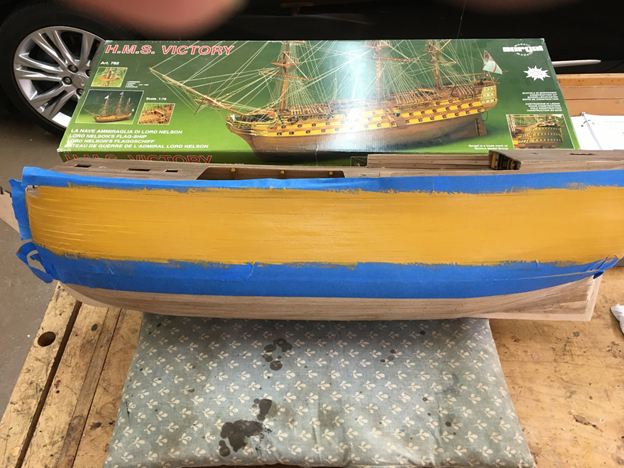
After the paint was dry I used the aforementioned template to locate the gunports, taking care to
move a few to positions where the ports could be cut without hitting one of the underlying bulkheads.
Once I had the port shapes scribed onto the surface I first drilled holes within those borders then use
a sharp Xacto blade to cut away excess and bring the openings to their final size. The kit provides nice
brass “frames” for the gunports and I used those to insure that I had the holes square and of the right size.
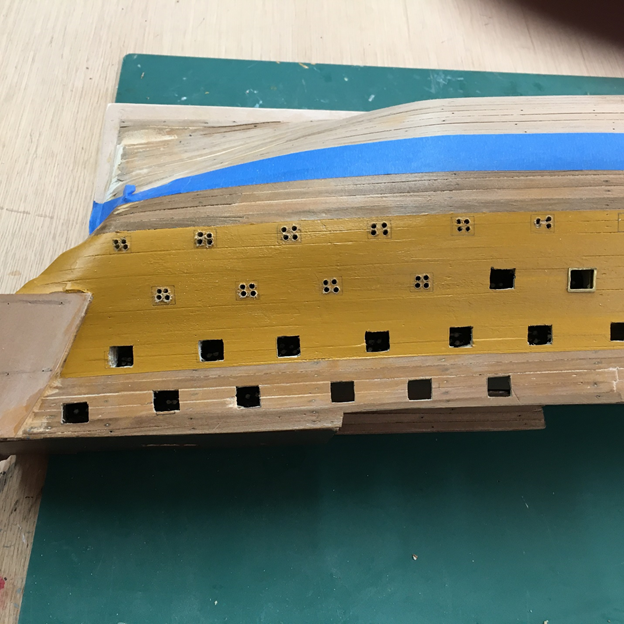
Before cutting the two lower rows of gunports I installed the gunwales to ensure that the ports were properly positioned between them.
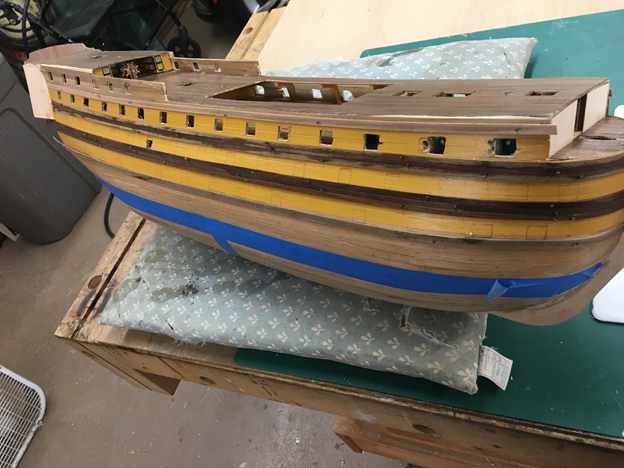
At some point you have to assemble the gunport covers, and it’s a step-by-step process of cutting the cover, planking it with two small planks, painting them yellow on one side and red on the other, then installing the associated hardware. If I had it to do over again I’d skip doing the extra planking – it just makes the cover thicker than it needs to be and adds nothing of any value.
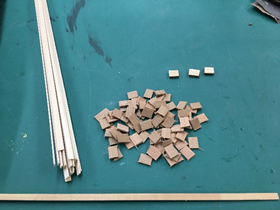
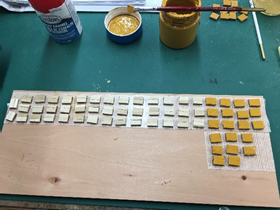

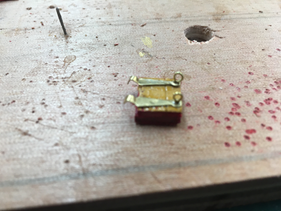
Once I had the gunport covers all cut out & painted I set them aside and assembled the bow components.

As mentioned earlier, brass frames are provided for all the gunports. They must have the inside edges painted red. Then brass drip moldings are glued on over the gunports on the two lower decks – and they are differently shaped for some reason. Note the lower hull copper cladding. More about that in a minute.
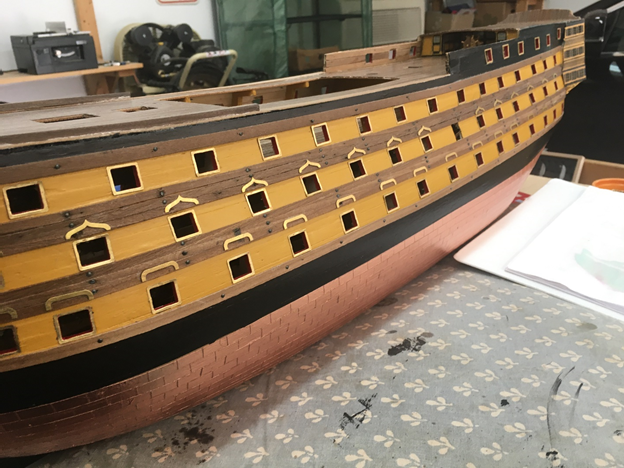
The next picture shows the aft crew and captain’s cabin sides fully installed.

As I mentioned much earlier there were several pieces in this kit that were formed from thin plywood and stamped with a faux gold color. I didn’t like them much but managed to make them work by (a) painting all of the windows a light blue, and (b) coating all of the cabin pieces with Minwax semi-gloss water-based arylic. It all came out much better than I had hoped. Note that these parts got a semi-gloss finish as opposed to the decks that got a matte finish.
The copper cladding bits were not included in this version of the ship, which is just as well since I had hated trying to install those things on the Mantua Cutty Sark that I completed a couple of years ago. I instead used 1/8” copper foil electrical tape for my cladding (manufactured by PEMOtech). It goes on very smoothly, and once it’s in place you can add vertical slits to emulate the plates. Teensy rivets for authenticity? Nahhh.
To add durability I coated it all, along with the rest of the hull, with the Minwax matte finish acrylic. It looks great and I strongly suggest you consider it if you plan to copper clad a ship model. It comes in a variety of different sizes too.

The next picture is meant to show what carelessness can look like.
It all cleaned up OK, but yuuuck!
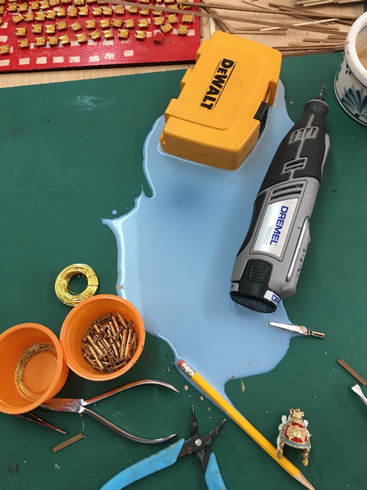
Each cannon on the upper deck and the lower gundeck had to be assembled.
The cannons on the lower decks are simply glued into holes drilled into gun
support rails inside the gunports.
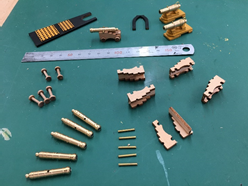
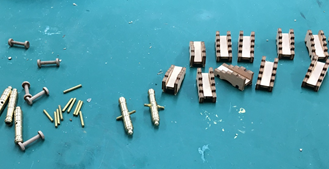
By the way, if you’ve ever tried to assemble a model like this you know how difficult it is to handle the thing and hold it in any particular position while you make additions. Paint smudges, bits break, etc. Ugh.
So when I discovered the PANA Vise I was ecstatic. I was able to twist and turn the hull in almost any direction and fix it in place to add bits & pieces on the sides and deck. I used this device throughout the hull assembly process and it's a lot more versatile than a simple keel clamp. I highly recommend it.
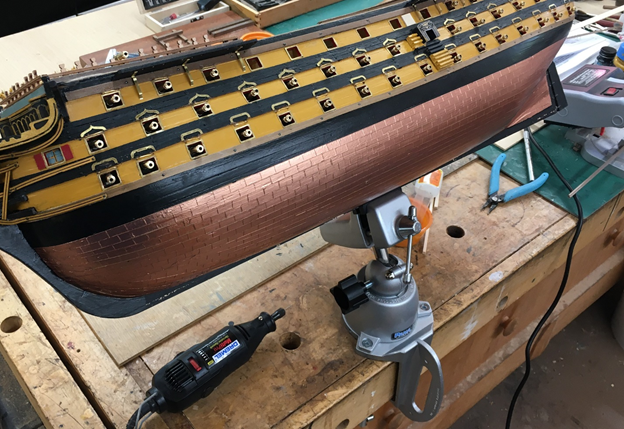
From this point I'll just add pictures of various additions to the hull and deck construction with brief comments...

Sea gangways & cannons installed. According to the plans the cannons should be flat black.
I like them better with their unpainted brass finish.

Cannon port covers. Tedious job, not well-explained in the plans. The gunport covers have to
be attached to the hull but there is no description re how to do that. I finally created wire loops
just above the gunports and hung the hinges on them, adding a drop or two of super glue to
hold them at the right angle. Then I inserted thread into holes I drilled in the hull, with a drop
of glue to hold those in place. Lastly I connected the thread to the eyelets on the covers and
trimmed off the excess. Only had to repeat this process 80 or 90 times. Gaaaack.
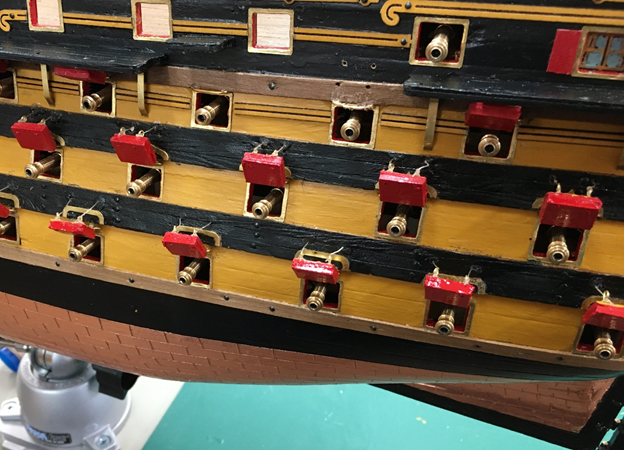
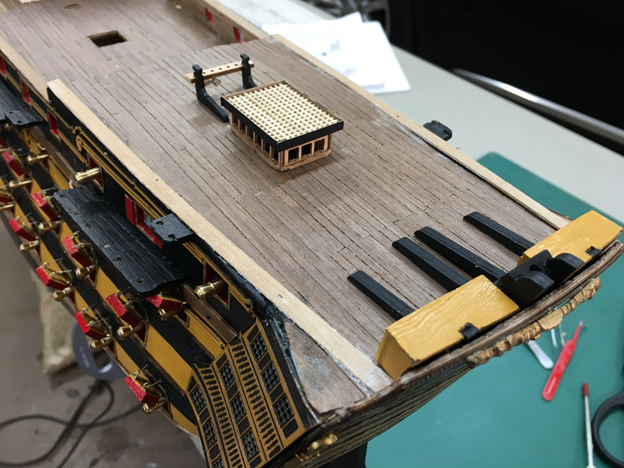
Captain's cabin skylight added, along with flag lockers at the stern. This was, after all, a flagship :):):)
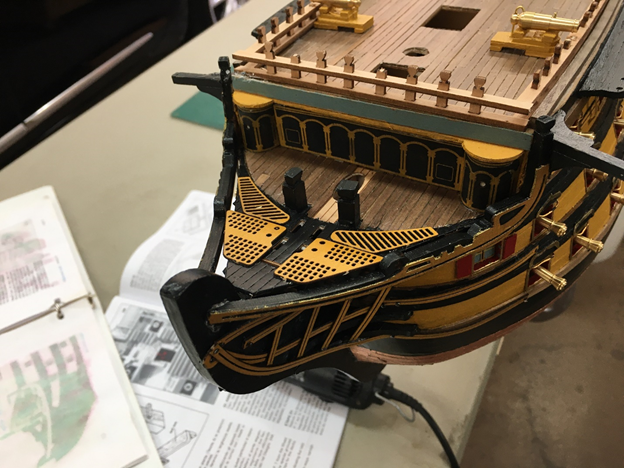
Additional details added to the bow construction.

Several other deck components installed.
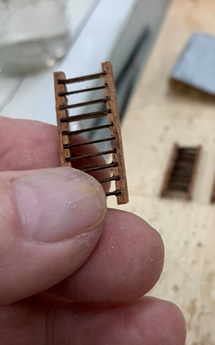

Ladders Banisters

Lower gun deck details (hatches, entryways); lifeboat supports
frame the hole in the deck.

Foredeck details (bitts, cannonball racks, hatches, belfry, etc.)
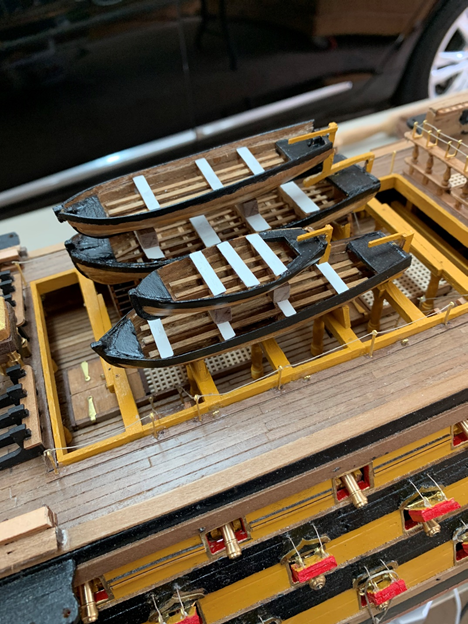
Lifeboats completed and installed. Never did figure out why
there are four different sizes.
Basic rigging attachments installed (channels, chain plates & deadeyes).

The bowsprit is lashed into place at two points on the bow. No
clue in the plans re how to accomplish this. I used a nice big
curved upholstery needle to guide the cordage into place.
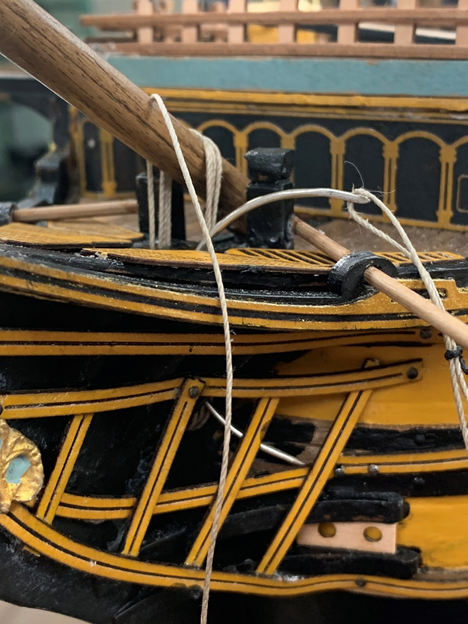
Foremast assembled and slipped into place.
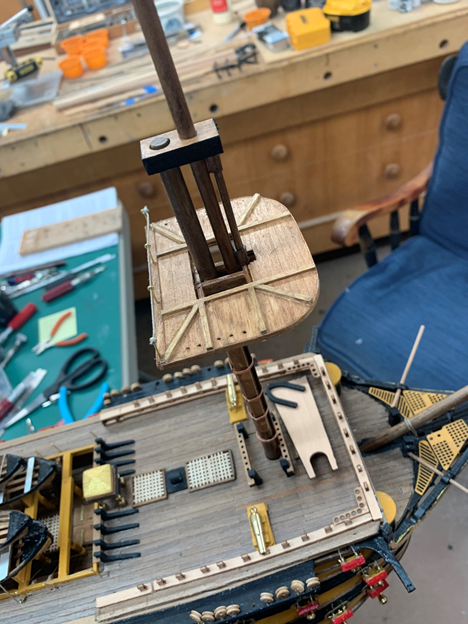
Main mast and mizzen masts added. Note cannons installed on
the deck and coiled ropes.

Beginning installation of upper ratlines/shrouds on one of the masts.
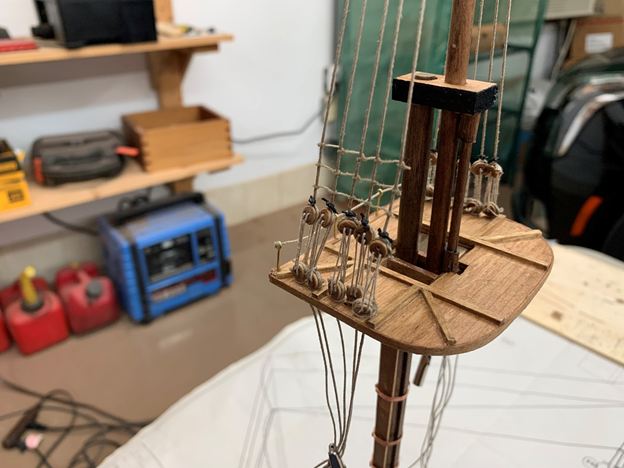
Mizzen mast w/upper ratlines completed w/assembled yards added.
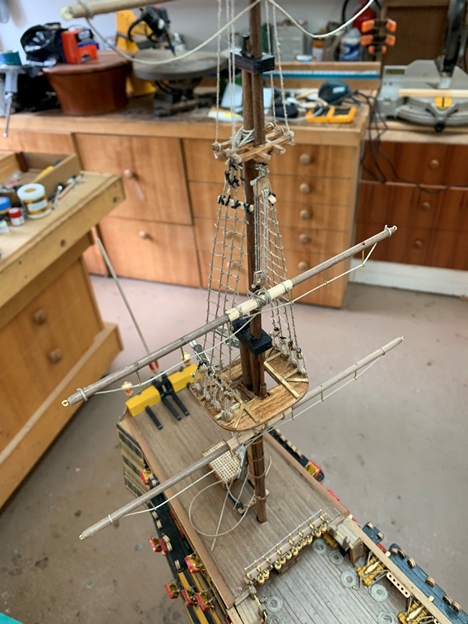
Figurehead painted and installed. Note heavy ropes holding bowsprit
in place and other rigging details.
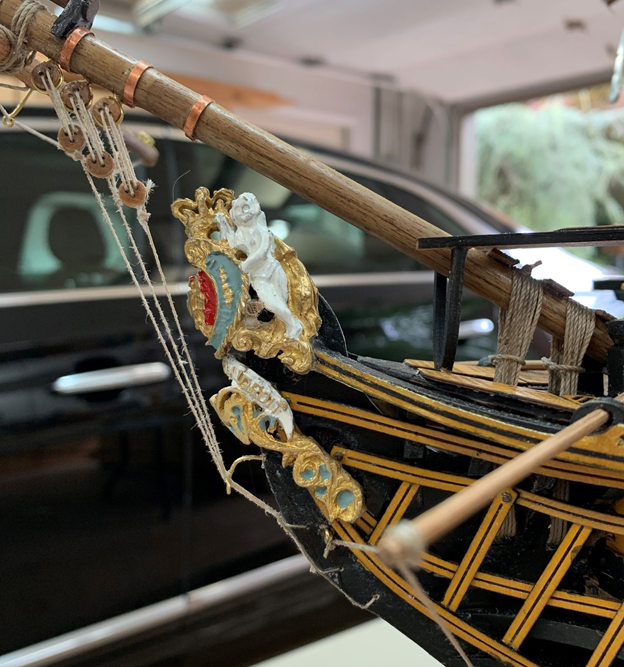
Four decorative lanterns (three on the stern and one on
the main mast) must be constructed using nice brass &
plastic components provided.
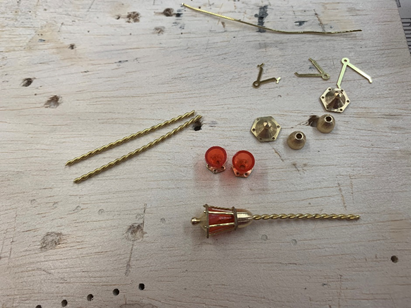
Bowsprit standing rigging details (note comfy chair and messy workspace).
I’m obviously not a neat freak. Or an especially good photographer.
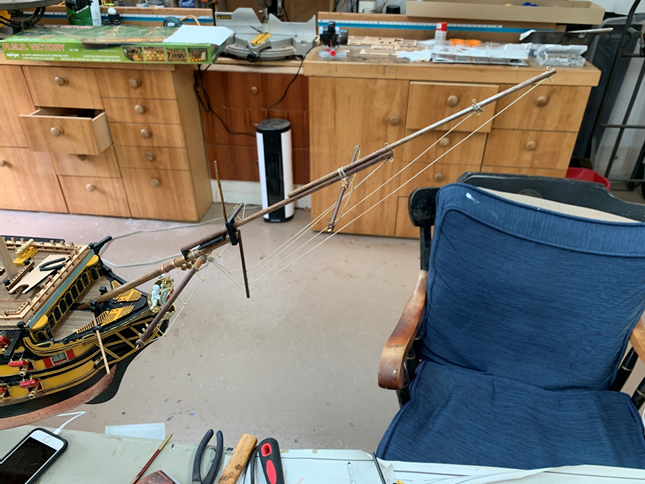
Closer view of main deck cannons and restraining rope attachment
schemes. Also note companionway to lower gun deck as well as
stairs/railings coming down from the forecastle deck.
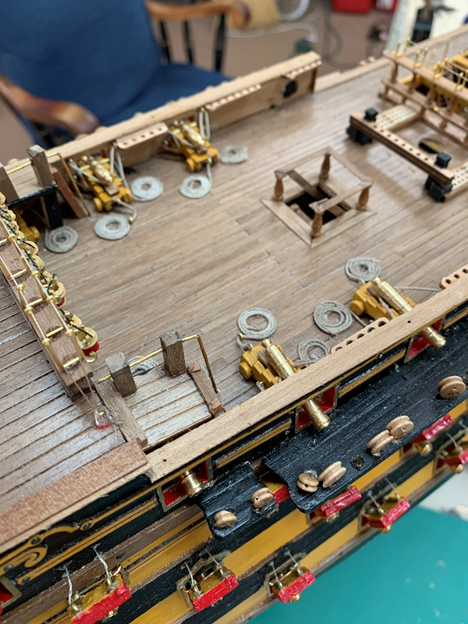
All three masts & bowsprit in place; ready to start serious rigging.

Will continue in a few days ...
HMS Victory Build Log -- Part 3 -- 3/1/21
Here's the rest of my HMS Victory story..
The railings provided with this model were basically u-shaped brass loops into which you were supposed to neatly insert a folded black nylon mesh. They call it “hammock netting”. They look fantastic on the finished model
in the plans and the box illustrations (see picture below), but when I was challenged to perform that scheme I completely failed. Probably the fussiest thing you are expected to do on the whole model. Sooo, I ordered some appropriately-sized 3-hole stanchions from Ages of Sail and constructed the ship railings with them. Again, probably something only an expert model maker would notice, but it sure looks better than what I was doing.
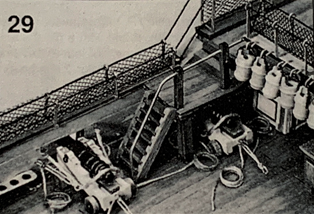
Chain plate construction & attachment

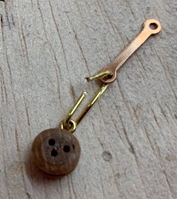
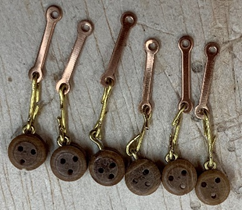
First chore in the transition from hull building to rigging was assembling the three masts. As I mentioned in the beginning, I didn’t do a very good job of memorializing every step of this build. Here is a picture showing the
three masts after preliminary assembly and fitted to the hull.
 No good photography to show how it was done.
No good photography to show how it was done.
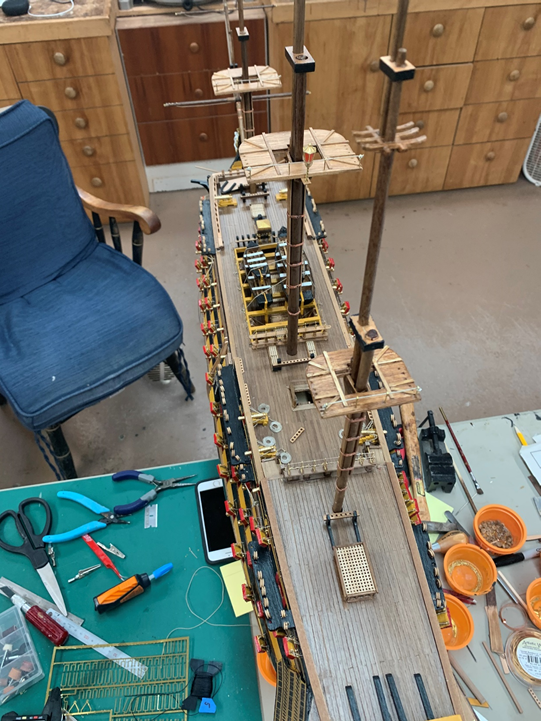
Some of the best clues re the rigging on this model are contained in the
excellent photos on the box – even though the paint scheme in those
pictures is nothing like the one described in the instructions …

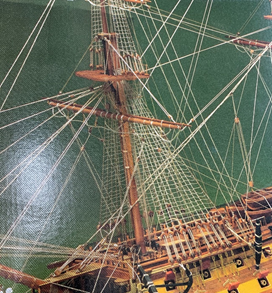
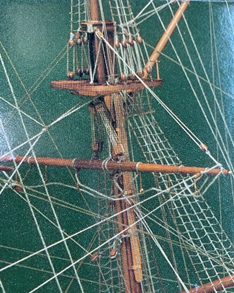
The picture below shows the foremast with the upper ratlines pretty much done. I’ve seen in some other build logs that I’m not alone in being confused when it comes to the attachment of yards to masts. In this case I chose to drill a hole thru the yard and the mast, insert a piece of brass wire, slip the yard on to that and then lash the whole thing into position. I’m sure there are better ways to do it, and hope I’ll learn what the trick is before starting my next ship. For the record, I don’t think anyone but another model ship builder will notice what I did.
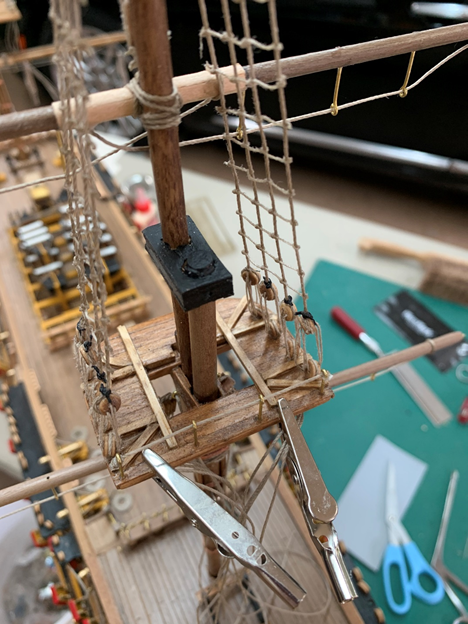
And now here are various shots of rigging in progress...
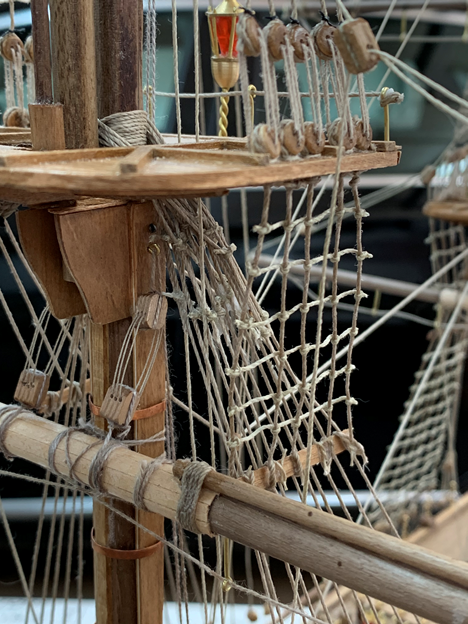
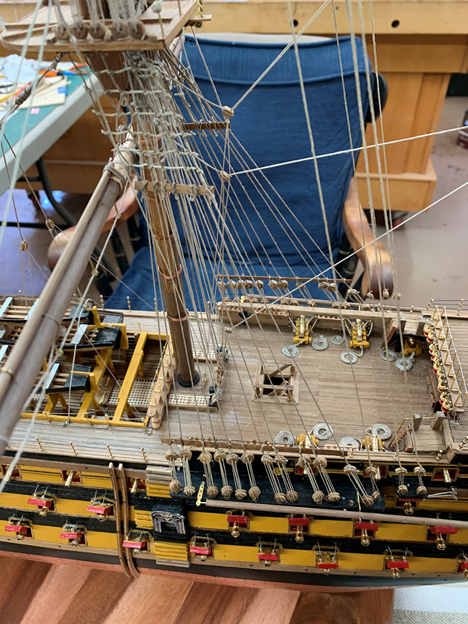
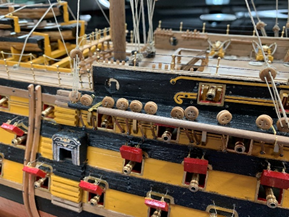
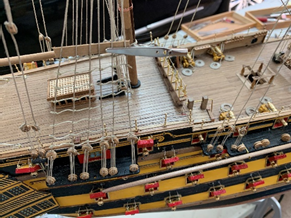
Doesn't this look like fun?

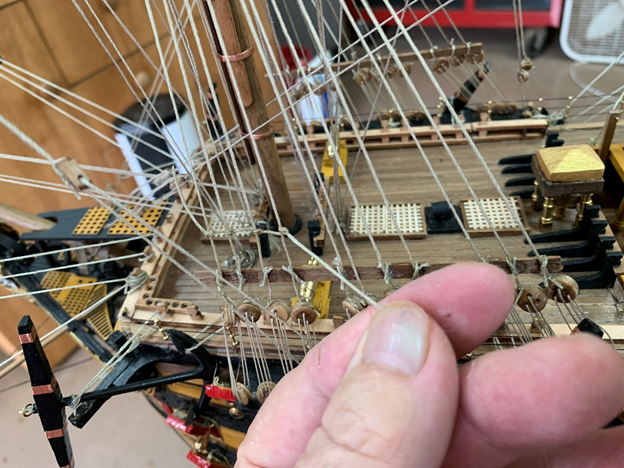
One work trick I learned was getting the ship in a position where it could
be turned around and be at an appropriate level to work on from a chair.
I salvaged an old ironing board that my wife wanted sent off to the dump,
and added a cheap 12” wooden Lazy Susan. Made the rigging challenges
a lot easier.
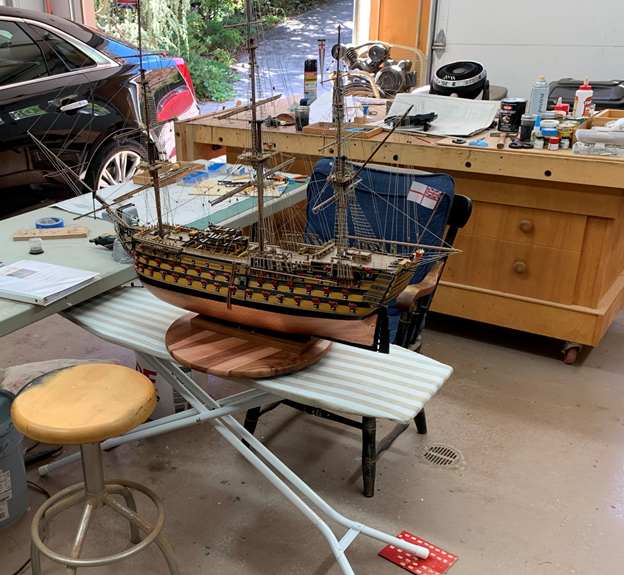
The flags that came with the model were unacceptable. Printed on some sort of thin linen
but only on one side. Soooo, I scanned the kit flags, dragged the scans into PowerPoint and
downloaded matching British flag designs from the Internet. I flipped and duplicated each
image then printed the whole page out on matte finish photo paper. Trimmed each image
and “glued” them together, back to back, with rubber cement. They were easy to bend and
furl, and they turned out great.
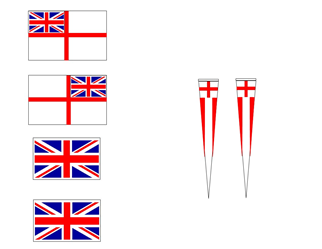
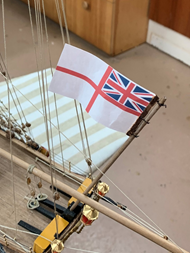
And so, the sun sets on my HMS victory build. It’s been a lot of fun and I’ve
learned many new tricks and techniques – mostly from the build logs of other
model makers who are a lot more skilled than I. MSW is a fantastic source
for people who are still just learning. Thanks to all.
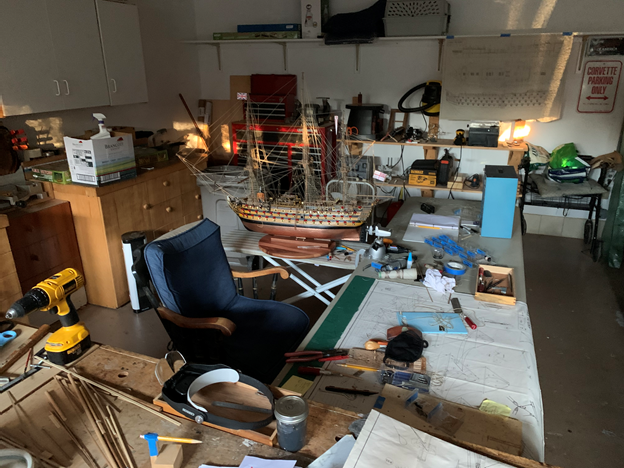
Finished Project
I moved my Victory into the house where it now occupies a place of honor in the middle of our great room.
Love it, love it love it.
Tom In NC
(Tom Hoxie)
Weaverville, NC
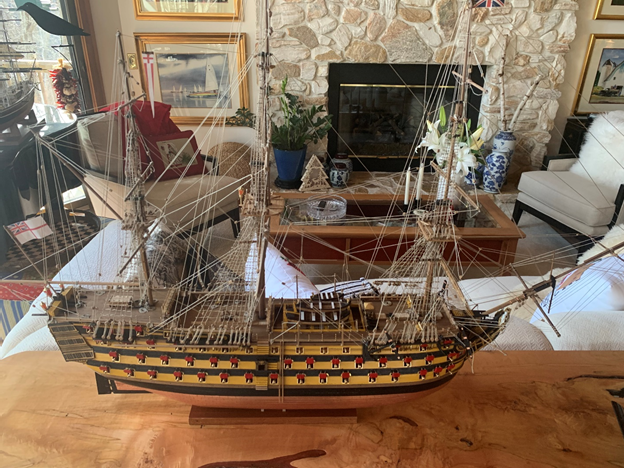
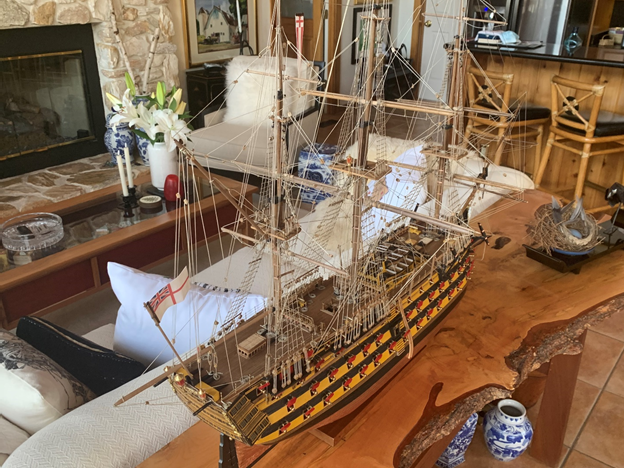
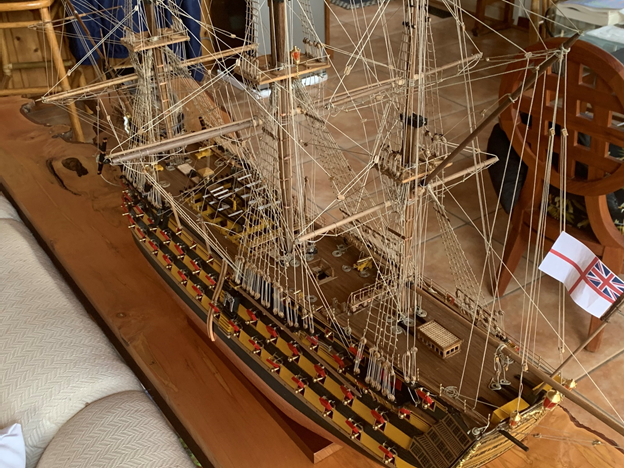
- BobG, GrandpaPhil and Rob S
-
 3
3
-
Chris:
Yep. I'm 77 years old, been retired for 20+ years, got over golf & woodworking after 15 years, and now really enjoy model ship building. Oh, and I haven't been able to get a COVID vaccination yet. When I was building my Cutty Sark a couple of years ago (which I finished in about the same amount of time as the Victory) I was flummoxed by communications with a fellow modeler who had been working on his Cutty for NINE years !!! I just can't imagine taking that long to do anything. Putting in just 3-4 hours a day can get a lot of stuff done while leaving me plenty of time for several other enjoyable pursuits.
Tom Hoxie
-
Previous Build Logs
Portland Paddle Wheel Steamer https://modelshipworld.com/topic/19493-portland-by-tom-in-nc-finished-bluejacket-shipcrafters-scale-18-my-re-entry-into-the-model-ship-world-after-a-45-year-absence/
Cutty Sark by Mantua https://modelshipworld.com/topic/19525-cutty-sark-by-tom-in-nc-mantua-sergal-scale-178-after-a-45-year-hiatus-i-thought-id-come-back-and-do-something-easy/
Chaperon Steamship Re-imagtined https://modelshipworld.com/topic/21519-chaperon-by-tom-in-nc-–-model-shipways-148-scale-–-renamed-“jezebel”-and-given-a-new-reimagined-history/
Caveat
This build log is being submitted after-the-fact. I started this project in March 2020 – just as the COVID pandemic was hitting full stride -- and was so immersed in it for the next nine months (finished the build in late November 2020) that I was quite lax about my photography and writing out my procedures. I’ll submit this anyway as I’m sure there will be many builders who will take this challenge on themselves, but I apologize for the brevity of the thing. This model is certainly not for beginners. If you have some experience and know what you're doing the final result will be very satisfying.
Purchase and Start-up
When shopping for this model in early 2020 I found there were very few to be found. European sellers were not parting with it for whatever reasons (taxes, trade barriers, ???). But I happened upon a kit that was available right away at Model Expo in Florida. On their web site at the time there were some interesting comments from the founder of Model Expo that tell of his years-long relationship (since 1971) with the designer of this kit, Sergio Fabrizi -- who has since sold the rights to this kit and others to Sergal.
I’m not sure, but I suspect that the model I got was previously owned and repurchased from the original buyer who stashed it on a shelf somewhere. It was in great shape, and I don’t feel I was cheated, but read on to see why this matters.
The instructions that come with it are printed in a variety of languages, and I don’t mind saying, the translations leave a lot to be desired if you are an English-speaker. But there’s a helpful solution.
Supplemental English instructions for the Mantua 1:78 scale HMS Victory (version ART 738) are available as downloadable .pdf files (gasp) for free … my kit is an earlier version (ART 782) but the differences are not great.
https://www.mantuamodel.co.uk/downloads/2-uncategorised/37-english-translations
Scroll down the page and you will find 4 downloadable files – English translations for the ART 738 version of the HMS Victory. These instructions were great.
There is also a file re planking at the top of the list, and I found it immensely helpful. I’ve planked two ship models before, but I’m far enough from being an expert that every little bit of guidance helps.

The kit seemed to be in good shape -- even though it showed some signs
of being on a shelf somewhere for quite a while. At first glance all the bits
and pieces seemed to be included. Later on, I discovered some shortages.
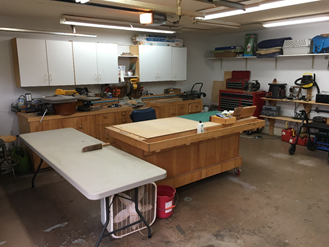

My garage work area was ready …

I mentioned that the English instructions I downloaded for ART 738 were a little different than for my ART 782 kit. One of the differences between the two kits is that some parts included in the later kit are made from brass, while in my kit they are mostly made from thin, printed plywood. They are OK, simply different than what I expected. How I dealt with them will be covered later.
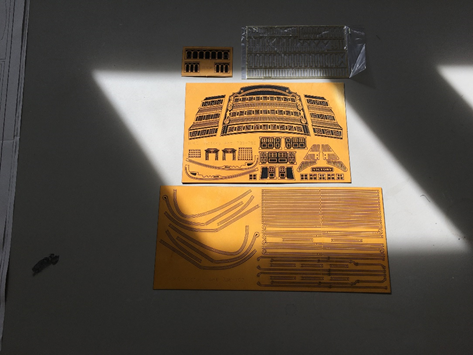

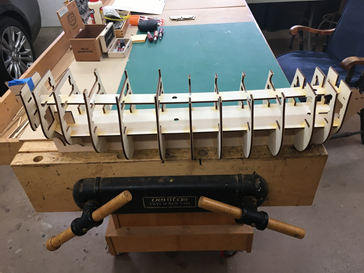

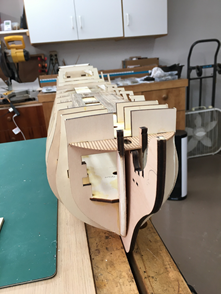
The laser-cut bulkhead and keel elements were well made, and I had little problem with alignment and assembly. Note that I used
the Veritas twin-screw vice at the end of my homebuilt workbench to hold things in place while assembling the keel.

Next step was installing and planking the lower gun deck. As you can see, I took the time to cut a good many deck boards in advance.
Problem with that was that I cut these elements from some 0.5 x 4 mm boards provided. I should have used the 0.5 x 3 mm boards the instructions called for. Grrrr. Luckily, I caught this mistake before gluing any in place. It’s hard to measure the difference between widths of 3 and 4 mm. I switched to the 0.5 x 3 mm boards, and after getting about ½ the lower gun deck done I realized that I didn’t have anywhere near enough of them to finish the lower gun deck, let alone all the main deck elements that would come later. Grrrr again.
I fired off an email to Model Expo, admitting my mistake with the 4 mm planks and describing the missing 3 mm pieces.
While waiting for what I hoped would be a satisfactory resolution I elected to start assembling the lifeboats.
There are 4 different lifeboats. They are also plank-on-bulkhead challenges, but much smaller.
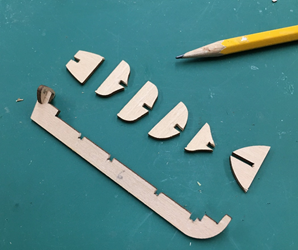
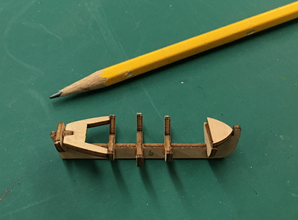
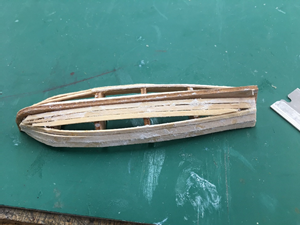
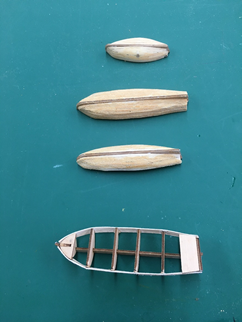
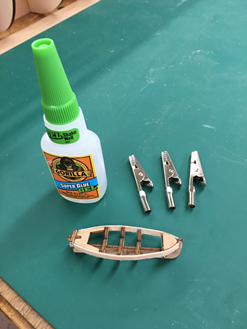
I used Gorilla Glue gel on the lifeboats because it does not drip like many glues, and it grips wet boards quickly.
Since I would be painting these little devils later the white residue that the gel leaves won’t be bothersome, but
you need to be very careful using gel where a white residue cannot be disguised.
After waiting for a week, and not hearing back from Model Expo I just assumed that they had to close shop because of the Covid-19 virus. So, I proceeded to hunt for the planking I needed online. Another of my favorite model-making supply shops came through in spades. Ages of Sail https://www.agesofsail.com/ shipped me a supply of 0.5 x 3 and 0.5 x 4 walnut strips within a week. Great quality too.
While I waited (I am obviously not very good at waiting) I finished the lower gun deck with some of the 0.5 x 4 mm planks I had pre-cut knowing that they wouldn’t show very much when all was said and done. I also painted the lower deck bulkheads with the ochre yellow paint called for. Found some artist acrylic stuff on Amazon that worked great. Have enough left over to do 2-3 more ships

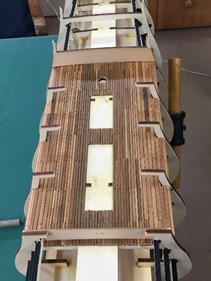
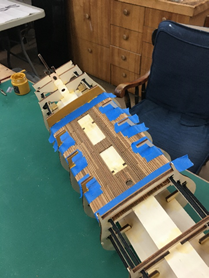
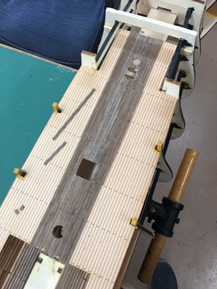
With the lower gun deck “complete”, and with the new supply of walnut deck planking,
I put away the partially completed lifeboats and moved on to installing and planking
the main deck.


When the deck planking was complete I coated each deck with Minwax water-
based, matte finish, polyurethane. Great stuff.
Planking the Hull
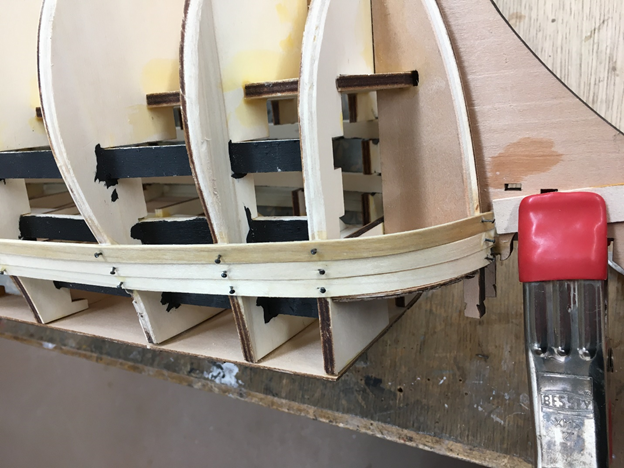
Note that you need to bevel the edges of several bulkheads so that the planking can wrap around them properly and provide a good gluing surface. The black boards you see inside the bulkhead structure are where you will mount the cannons eventually.
By the way, one HMS Victory build log I have read included some comments about the wood being so brittle that it cracks when bending it. That will almost always be the case unless you soak the wood. I found an appropriately sized plastic tray at Lowe’s that allowed me soak my hull wood for quite a while before attempting to bend it. It’s really quite flexible when thoroughly wet.
I use small nails to hold the planks in place while the glue dries. I use pin insertion pliers designed for that purpose (https://www.micromark.com/ ) and the nails go in easily through wet boards.

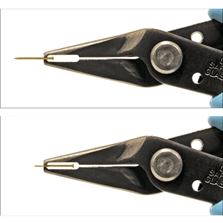
When I got to the point of tapering the planks into the stern I realized that other than some pictures there were no instructions to help me decide how to do that. See how the planks end awkwardly in the picture below.
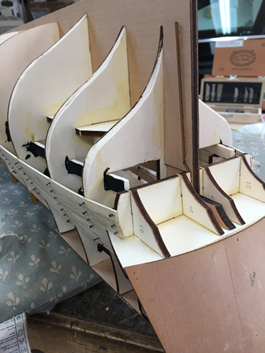

So I fashioned some “filler” pieces from scrap plywood that allowed me to wrap the planks around to a better position.

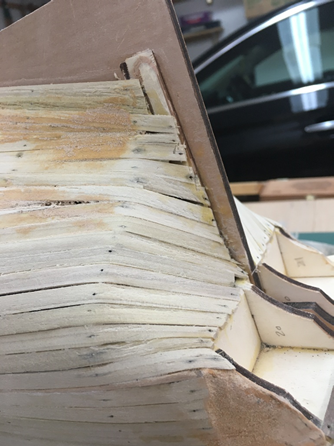
Appearance didn’t matter much in this first layer of hull planking, so I “sculpted” the area with wood filler.
The final planking layer would later cover that. Pretty ugly, but effective. The rest of the initial planking at
the rear was again something to figure out from pictures – little or no instructions.

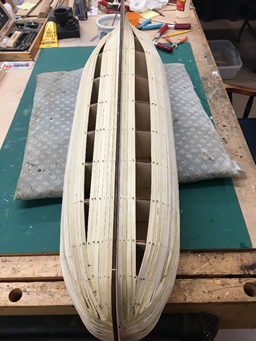

The way I look at it, the initial planking is where you establish the right curvature and shape of the hull.
The fact that it’s ugly doesn’t really matter. Wood filler rules !!!
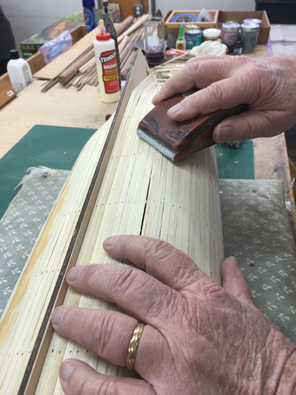

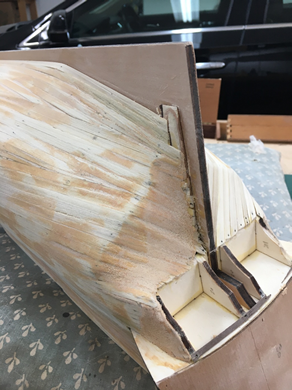
Once the first course of planks is laid you can start filling, sanding and smoothing. The metamorphosis is very satisfying.
You start out thinking “this is not going to work”, but somehow it does.
Somewhere along the way I decided that it might be a good idea to try on the template that determines where the cannon ports will eventually go. The directions didn’t recommend this – but I had a premonition.
I first marked the position of the bulkheads, then positioned the template.
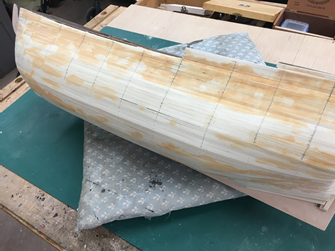
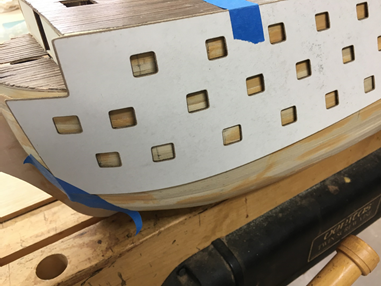
Sure enough, some of the the cannon ports lay right where a bulkhead lurked beneath (see the lines showing up below).
I still don’t know why that happened, but forewarned is forearmed, and I knew that when it came time to cut the ports I’d
have to make adjustments.
So. on to the second layer of planking, and this time appearance counts a lot more.

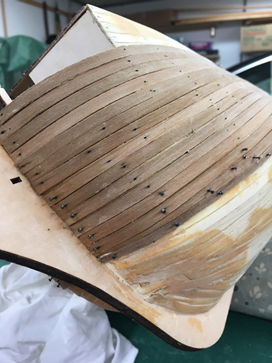

The planking instructions I suggested that you download from the Mantua site were quite helpful. They aren’t specific
to this model, but they give you step-by-step advice re tapering boards and filling the curved spaces efficiently. The final
sanding and shaping is very important.
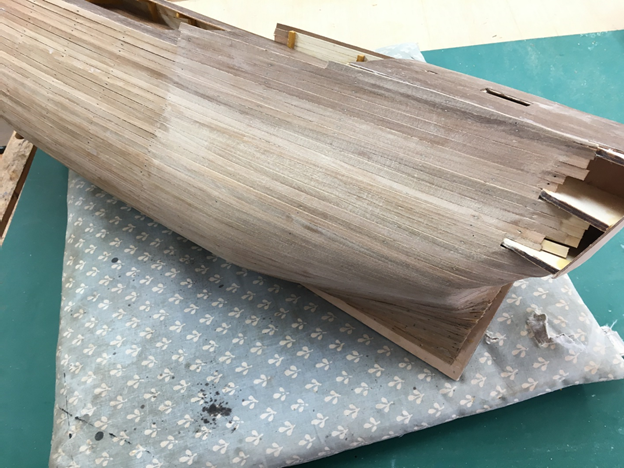
I'll try to file the next installment of this build log in a few days.
- Duanelaker, JeffT, ccoyle and 1 other
-
 4
4
-
Yves ... thanks for your comments. No, I don't plan to add any people even though the Statute of Limitations has probably run its course.
-
2nd & Final Build Log Entry – Chaperon aka Jezebel
My apologies for taking so long to provide some closure on my Jezebel project. I had two surgeries to remove a large kidney stone in November, and then had gastric bypass surgery in late December. I’m just now starting to eat soft foods again and I feel fine. Have lost 30 lbs so far and hope to lose another 100 lbs by year’s end.
But enough of that. I finished Jezebel back in November but failed to do a very good job photographing my last steps. I’ll share as much as I can using pictures of the finished model.
If you’ve read this build log so far you’ll know that my “imagined” history for Jezebel (AKA Chaperon) has seen some changes as various folks made really good suggestions and comments. So let me get the story back on track in order to eliminate any confusion (or at least try to).
The enterprising young Kentuckian who conceived of making the old Chaperon a “party” boat during Prohibition finally settled on removing her engines and permanently docking her in Newport, KY, right across the river from Cincinnati.
I don’t think they had very good aerial or satellite photography in those days, but if they had, here’s what the overhead scene would have looked like.

The boat shown here is moored facing upstream. Jezebel was tied up with her port side toward the dock.
Having settled on this arrangement, I set about completing Jezebel with several modifications. As you’ve already seen, I created a saloon and casino area on the lower deck where the engines used to be. I also figured out a way to expose one of the enlarged bedrooms on the upper deck. All these spaces were also lighted so that folks could look inside. Pictures and details coming up.
Also, since people were now boarding from the port side, I eliminated the large front gangplank altogether.

Here’s the final layout of the saloon & casino. The 1/48 scale furniture came from an English company that produces a wide array of dollhouse furniture in several different scales. The name of that company is Seaside Miniatures and they can be found on Etsy. You’ll see as we go long that I used a goodly number of their furniture bits, and a few I built myself, to add to Jezebel’s “party” boat theme.
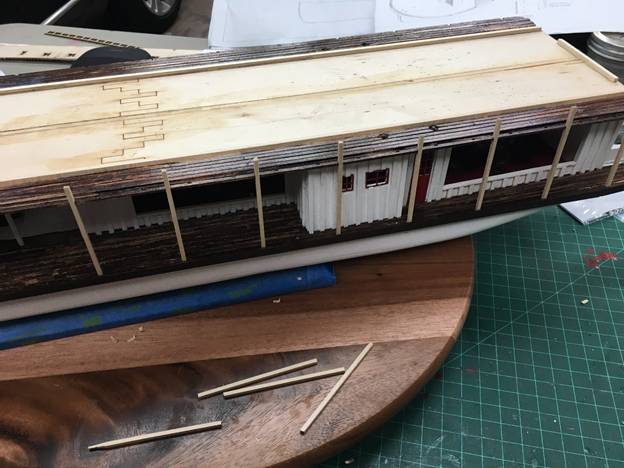
As I prepared to install the boiler deck (mis-named because the boiler is located on the main deck) it was crucial to dry fit everything carefully.
When laying the individual deck pieces in place I realized that the holes for the 3/32” stationaries were not going to line up. I did something wrong when completing the main deck that made it a bit wider than it should have been.
To cure this problem, I had to widen the boiler deck by inserting a scrap wood spacer down the centerline before gluing it together.
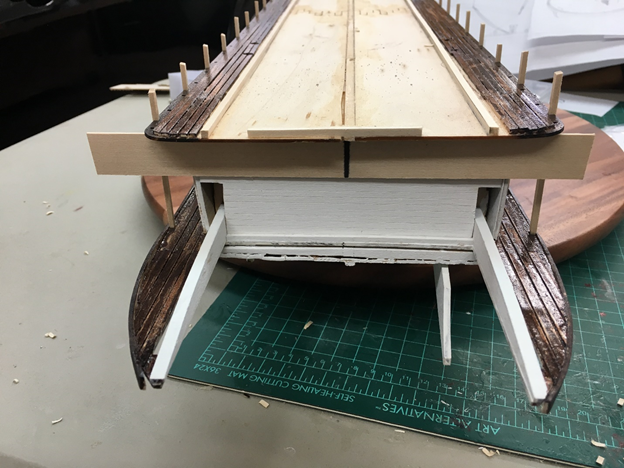
I also installed deck planks like I did on the main deck and applied mahogany stain to them before attempting to install the boiler deck.
Note the 3/32” stationaries were all dry-fitted to aid with the final alignment of the deck before gluing it in place. I also used some
blue painter’s tape to line things up.
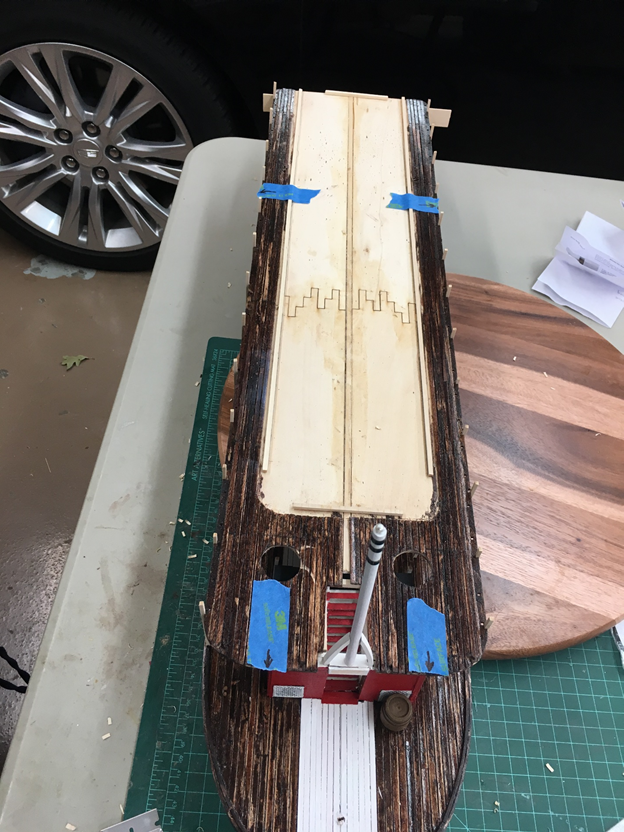
After applying a liberal amount of wood glue along the top of the lower deck walls I held the boiler deck in place with
two paint cans and let it all dry overnight. I was greatly relieved to find that it all lined up when it was done.
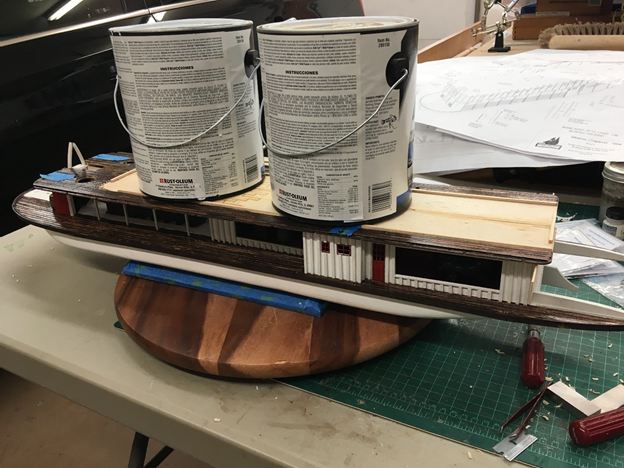
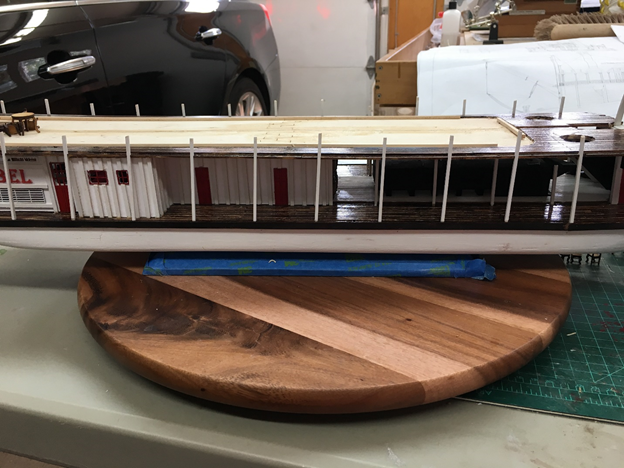
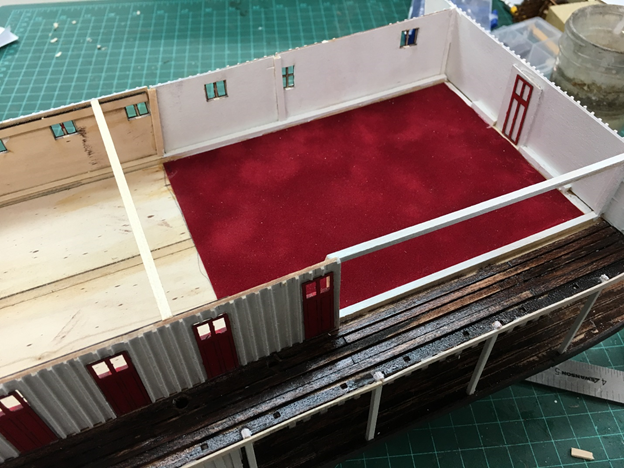
As I installed the boiler deck walls, I devoted a space at the stern end for a large bedroom. Initially I planned
for viewers to be able to see inside by removing a section of the port wall. Later on, I decided to remove part
of the “roof” too.
Once again, I used appropriate book cloth to represent wall-to-wall carpeting.

It was about this time I decided that the saloon, casino and bedroom all had to be lighted. No way anyone was going
to be able to see inside otherwise.
A visit to my local hobby shop revealed that there any number of LED lighting accessories for use in model train layouts.
I selected a battery-powered set with an off-on switch and brought it home to puzzle out how to make it work with Jezebel.
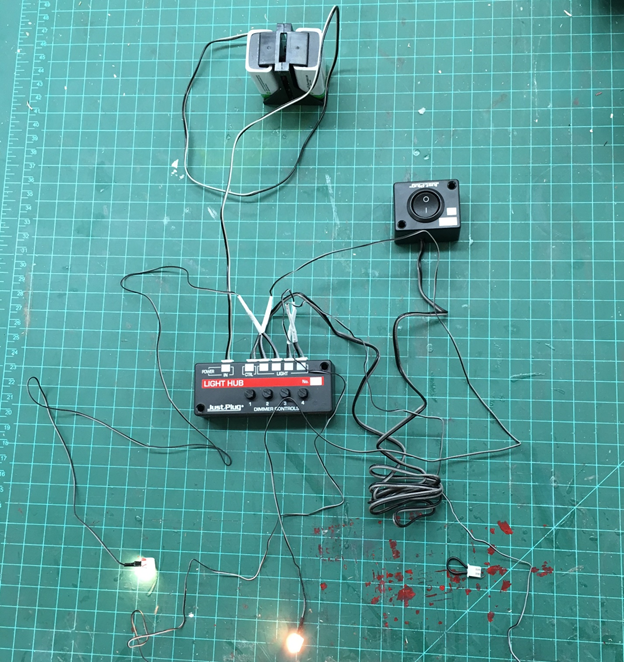
There’s a connector for 4 LED lights, an on/off switch and a battery pack.
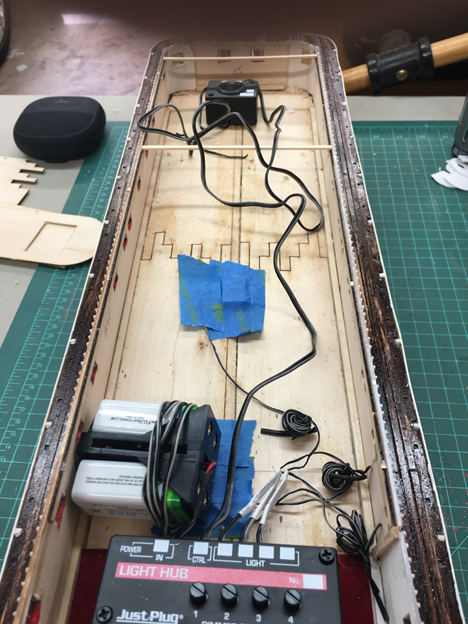
This is a little hard to explain, but I located all the light gear just forward of the bedroom.
As you’ll see later it will be accessible for battery maintenance via a lift-off panel on the
next deck up.

With three of the LED lights in place above the saloon and casino I was happy with the lighting effects.

The Hurricane deck house contains the on/off switch for the lights.
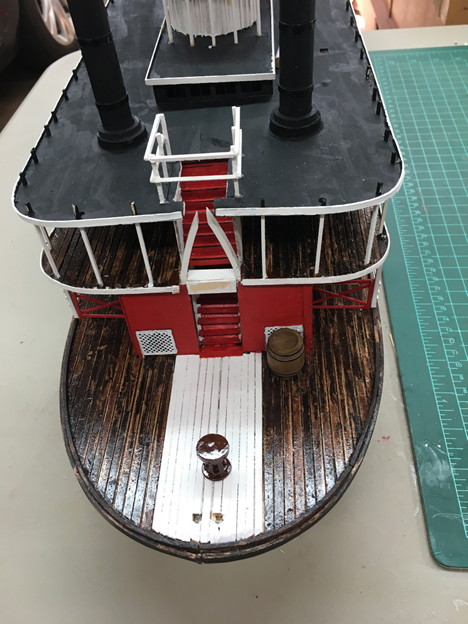
As mentioned earlier, since Jezebel was to be located with the
starboard side against the dock I eliminated the large gang
plank on the bow.
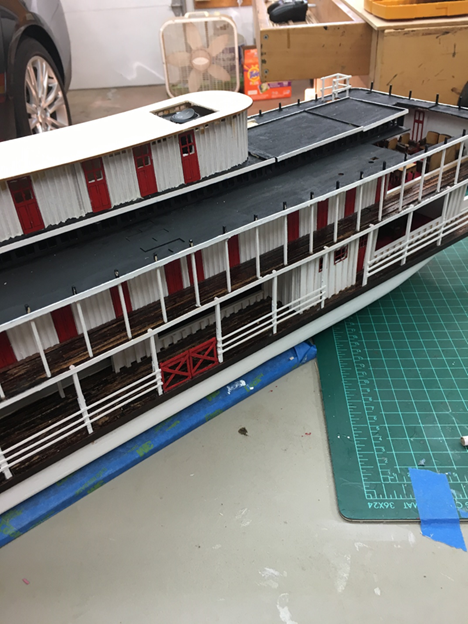
Here’s the new boarding gate on the starboard side where visitors will
now arrive. Imagine a set of boarding stairs on the dock.
Also note the “lid” on the Hurricane Deck which hides all the lighting
equipment.
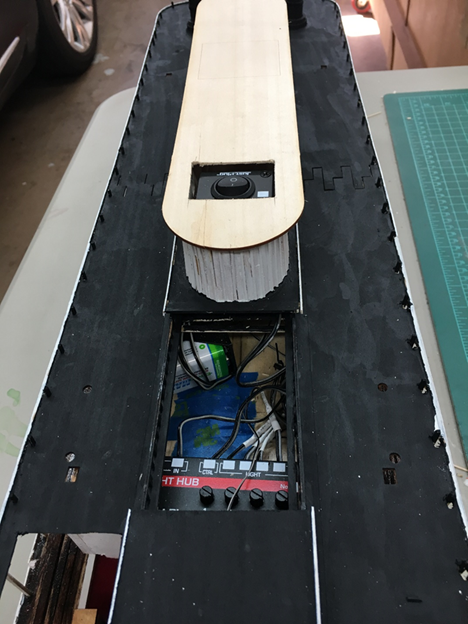
Here’s a shot with the “lid” removed. Note that the on/off switch is
located on the Hurricane deck where the wheelhouse will be attached.
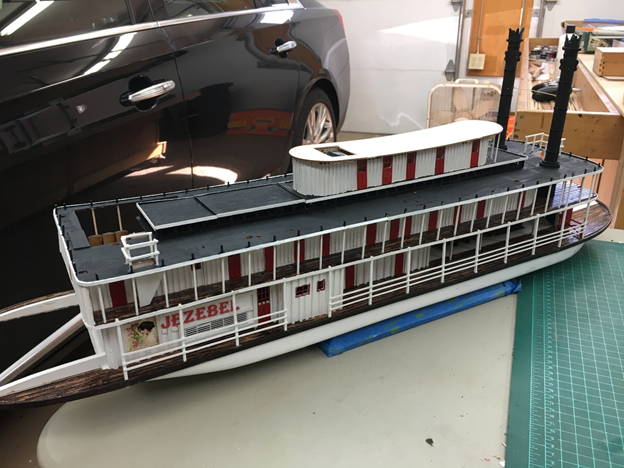
Here’s the side of Jezebel that river travelers see. Impressive signage and smokestacks standing tall & proud.
Probably some honky-tonk music too.

Here’s what the bedroom lighting looked like when finished. Cutting away part of the “roof” as well as the side wall
allows people to get a better view of the furniture arrangement. It also allowed me to include a lot more detail.
Once again, the 1/48th furniture bits all come from Seaside Miniatures (find them on Etsy). Good stuff, nice people.
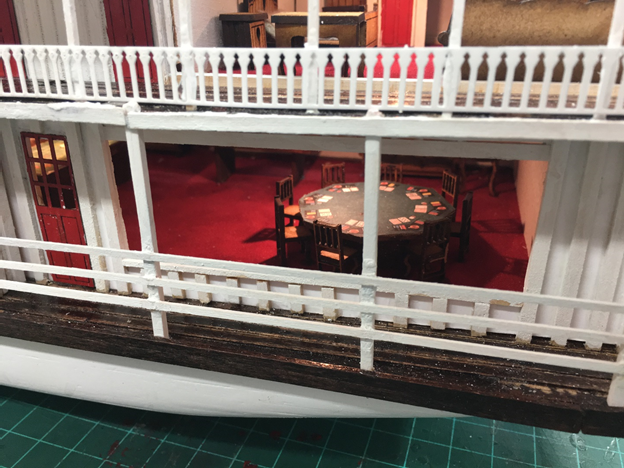
Here’s the casino. Craps and blackjack tables added later.
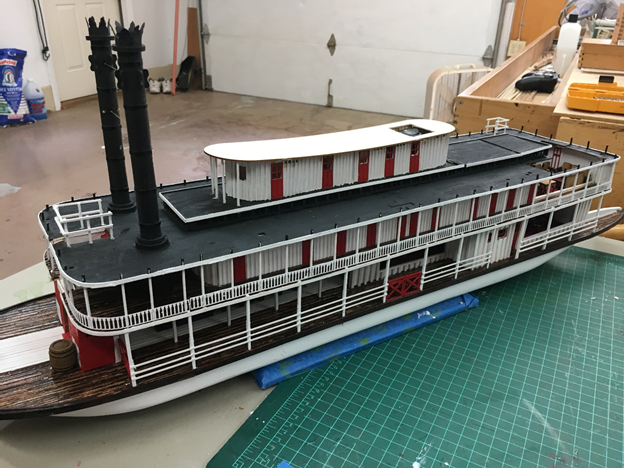
Ready to install Hurricane deck details and wheelhouse. Note that the main deck railing has been cut down
to people-size … horses will no longer be coming aboard … and the uprights and detail grille work has been
added to the boiler/bedroom deck.
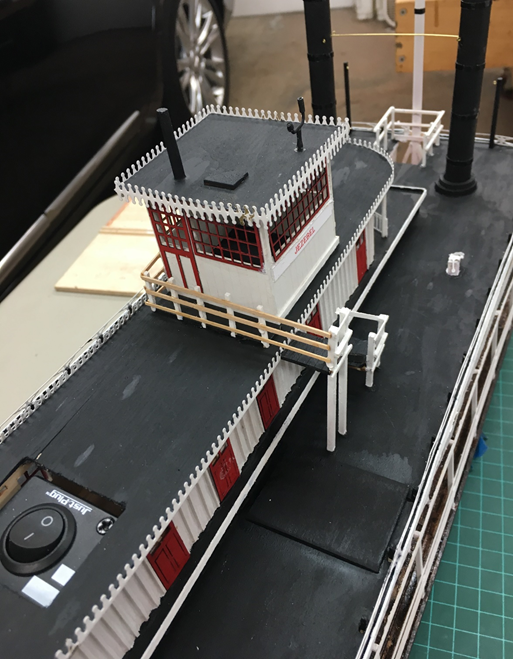
In this picture the completed wheelhouse has been installed, and the
wheelhouse ladder & railing assembly is just about done. The square
“patch” on the deck below the ladder is merely a cover hiding the
Unfortunate seams where the decking comes together.
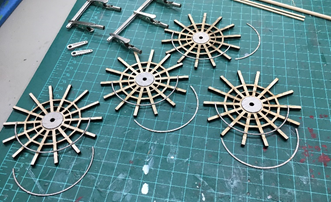
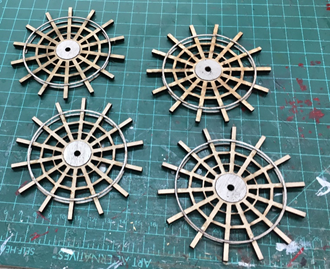
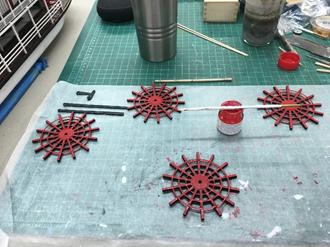

I was not looking forward to fabricating the paddle wheel, but it
turned out to be much easier than the double paddlewheels I had
to fabricate on my model of the Portland a year or so ago. Note the
use of a small square to keep the wheel segments aligned while the
glue dried.
And now for detail shots of the finished boat …

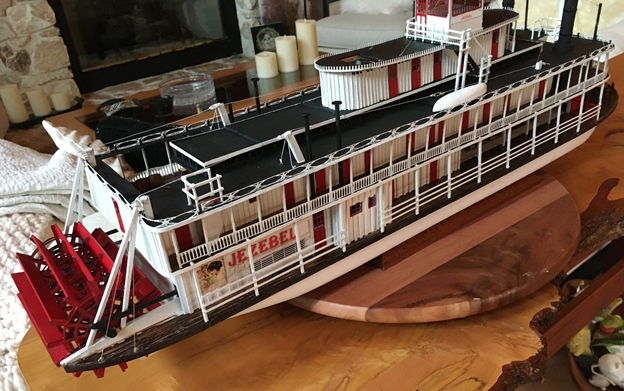
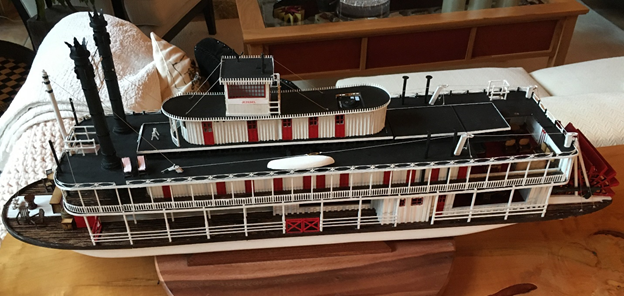
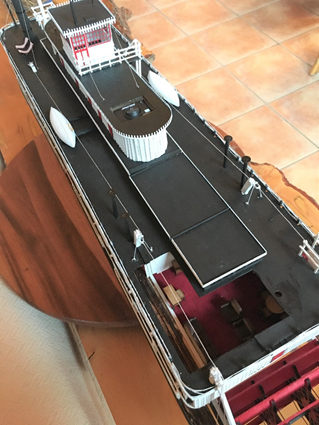
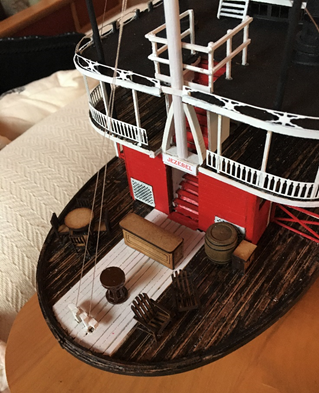
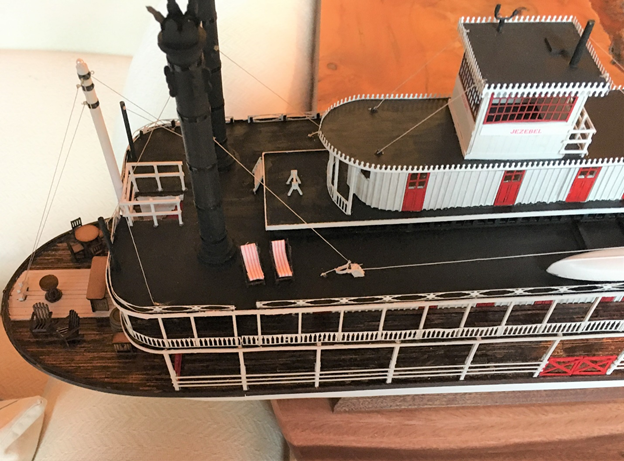
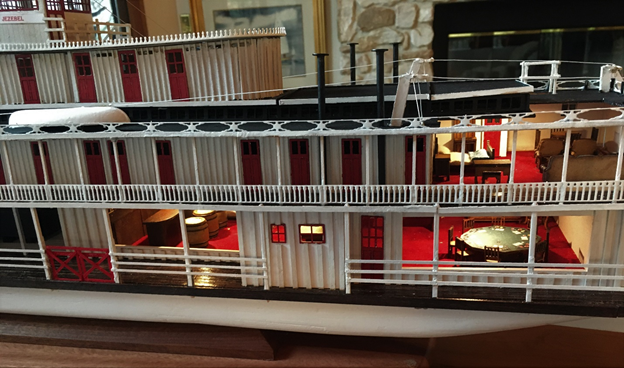

Thanks for following along … and for the many comments and good ideas. This is a fun model to build, and the quality is very good.
If anything doesn’t look right, it’s my fault.
I have no idea what my next project will be, but I’ve had some pretty strange ideas. How about a 4 ft tall, highly detailed pagoda with
instructions all written in Japanese? Or maybe a $1,250 model of the Bon Homme Richard? 44” long and complete with all Chinese
language instructions.
Hmmm. Or maybe something else.
See y’all later.
Tom Hoxie
Weaverville, NC
- Altduck, yvesvidal, GrandpaPhil and 1 other
-
 4
4
-
Thanks Brian. I hope you have as much fun building this model as I have. Cathead has advised that Kurt Van Dahm sells an excellent extended tutorial on building this kit . I looked at it, but given how far I've already gotten I passed up the opportunity to buy it. I'm kinda stubborn and most of the fun I get out of ship building is running into unsolvable problems and solving them myself. In my last avocation following formal retirement I got into woodworking, then designing and building Asian-inspired furniture. No formal education, just Googling for answers and a pretty good imagination. Did it for 16 years and paid for about $15,000 worth of tools two or three times over.
Best of luck...
TOM
-
Bob:
You and Eric (and probably many more in this forum) are so knowledgeable on these arcane topics that a knothead like me hasn't got a prayer of sneaking anything by. As I hinted to Eric, my revised story line will likely see Jezebel living out her last days as a wharf queen. With her big steam engine removed to provide room for a saloon and casino she will have to stay lashed to the shore, attracting visitors with flashing lights and hints of pleasures not fully described. I plan to moor her on the banks of the Ohio River in Newport, KY.
Bringing in some facts from Wikipedia, and adding some anecdotal memories of my own, here's why that's the best place for her to be ... Prohibition under the Volstead Act of 1919 resulted in a widespread illegal sale of alcohol. Many gangsters began to smuggle alcohol into the city to supply citizens and businesses. Speakeasies, bribery and corruption became the norm in Newport. Upscale gambling casinos on Monmouth street added to its "sin city" reputation. Eventually, investigations for racketeering pushed out the casinos, which were replaced by peep shows and adult strip clubs. Many of the old businesses disappeared when parking became difficult on Monmouth Street and the commercial district opened on the hill of south Newport. Newport retained it's shady reputation up until the early 1980's when she seriously started cleaning up her act. That cleanup has been mostly successful.
I doubt Jezebel could get away with converting her boiler to being a still -- too many tell-tale smells to tip off any "honest" cops that might come around.
I hope despite my simplifying the story, and making it a bit more factual in the process, that you and Eric will help to keep me on the straight and narrow if I stray again.
All best,
Tom Hoxie
-
Sheer genius. I'll build that idea into the story. I'm still working on the engine problem. While trying to ascertain what type of engine and HP the Chaperon boasted I ran across your exceptional thread about steamboats. I'm pretty sure that my off-the-cuff idea about four Model T engines would provide way too little power. Four of them could only reach about 80-100 HP @ 1600 RPM, and if you multiply their torque (83 ft-lbs @ 900 RPM) by 4 you're still not getting a lot of ooomph. Knowing you're watching me, and what your level of expertise is, I'll need to be careful not to too carried away with my fantasies. The steam engine is irrevocably gone on this boat, so maybe Jezebel will wind up being a wharf queen after all. By the way, I'm a cat lover too so go easy on me.

-
druxey:
I'm glad you're enjoying it. Writing a book would probably be fun -- I did a lot of writing during my career -- but boat building has captured my interest right now, and at the age of 76 I'd really hate trying to start a new career that involved deadlines. With guys like Cathead watching me make mistakes and forcing me to invent some sort of excuse is about as fun as this gets.
Loving it all...
-
Eric:
I thought I answered your post this afternoon, but I don't see my reply here so I guess I still haven't figured out all the puzzles re build log posting, etc. This whole site can be rather opaque, or maybe I'm just sliding into dementia faster than I realize.
I'll look at what Kurt Van Dahm has to offer. As far as the engine room being given over to the casino on Jezebel you have a great point.
I'll try to come up with a plausible explanation. Plausibility ain't truth, but what the heck. Here's a stab at this quandary ...
Some of the most inventive people in the world are hotrodders. They've managed to devise some very unusual methods of locomotion far beyond what's standard. For instance, in 1960 Mickey Thompson showed up at the Bonneville Salt Flats intending to break the Land Speed Record with his Challenger l streamliner -- which was powered by powered by four supercharged Pontiac V8 engines, . He almost succeeded.
How about if our young Kentucky lad came up with a plan to power Jezebel with four Ford Model T engines? I can imagine getting rid of the huge steam engine, and hollowing out some hull space below the casino floor for that purpose. It would occupy a lot less space, and save a lot of weight. If he could pull that kind of modification off he could eliminate the need for the huge boiler, perhaps disguising it and packing it with elicit whisky storage. It would also allow space previously devoted to coal or lumber fuels to be used for something else. The Jezebel didn't have to be "just" a pleasure boat. Smuggling was a pretty profitable enterprise in those days. That explanation strains credulity, but my story about Jezebel was already doing that.
Thanks for making me think things through. This is fun.
TOM
Now let's see if clicking "submit reply" works this time.
-
Bob:
That's a wonderful bit of history. I had never heard of the Delta King before. When I was a lad in the late 40's the Delta Queen had arrived on the Ohio River and I believe she was actually based in Cincinnati. She may have been the largest sternwheeler on the rivers at that time and every visit to Cincinnati was widely covered in Cincinnati papers. Eventually she became involved in an annual race with the Belle of Louisville, (from Louisville to Cincinnati, I think) which had people crowding the shores to watch. Very popular event and obviously great PR.
More info on each boat can be found on Wikipedia. https://en.wikipedia.org/wiki/Delta_King https://en.wikipedia.org/wiki/Delta_Queen
Now, did you have any opinions re the crazy way I'm building the Chaperon/Jezebel?
Tom Hoxie
-
KIT OVERVIEW
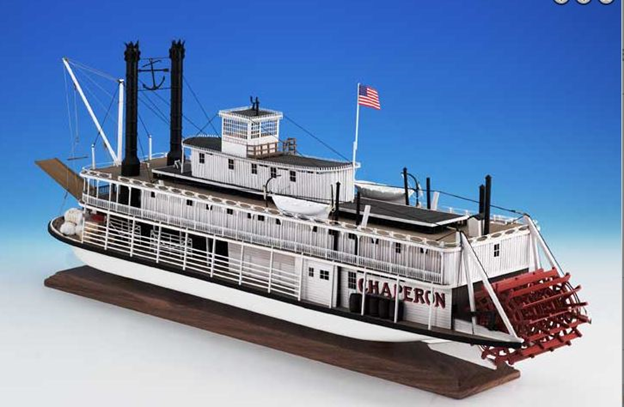
Manufacturer: Model Shipways, U.S.
Model: MS2190 Chaperon, Sternwheel Steam Packet, 1884
Dimensions: Length 34-1/2”, Beam 7-1/2”, Height 12”
Scale: 1:48
Purchased: 2019
Price: $269.99Design, plans, instructions & prototype model by Bob Crane
The model you’ll build from Model Shipways' kit will be a historically accurate (if you want it to be) and perfectly scaled replica almost three feet long. An amazing number of laser-cut basswood and limewood parts make up the hull, superstructure, paddlewheel, gangplank and railings. A photo-etched brass sheet provides incredible ornamental detail. Other brass parts include bell, eyebolts, cleats and nails. Ready-to-use Britannia metal lifeboat, lanterns, capstan and whistle, hardwood blocks and three diameters of rigging line add life-like authenticity. Six sheets of plans and clear assembly instructions pave the way to a magnificent model.Comments from Tom in NC re the kit: Laser cut parts (and all others) seem to be top of the line as noted above. Very nice. The instruction booklet is also pretty good, but leaves several things hanging out there for you to puzzle out yourself. No biggie.
As noted in the title, I’ve reimagined the Chaperon’s history and my revision will affect my build in several ways. I hope the designer and original builder of this kit, Bob Crane, will forgive the liberties I'm about to take.
The real Chaperon burned and sank in 1922. It was near the end of its useful life and it was hauling freight up and down the Tallahatchie River in Mississippi. I thought that was a rather sad ending for a memorable boat, so I made up a story that said the boat was still afloat after 1922, and that it was given a new and unusual second life. The 1920’s were a significant and unique era in U.S. history, and I just made things up accordingly.
Prohibition in the United States was a nationwide constitutional ban on the production, importation, transportation, and sale of alcoholic beverages. It started in 1920 and lasted until 1933. Many people thought prohibition was a grand idea – but many more did not. As a result, criminal gangs were able to gain control of the beer and liquor supply in many cities. The inland waterways in this country provided a handy way to smuggle whiskey and beer to our major cities in the Eastern U.S. – Chicago in particular, where Al Capone and other criminals ruled the roost. There was a general lowering of inhibitions during that time and some pretty rampant lawlessness ensued. Coincidentally, this period was also known as “The Roaring Twenties.” Ahhh, yes.
Several small cities well south of Chicago, like Hot Springs, AK and Newport, KY, became mob controlled “playgrounds”. Municipal corruption, open flouting of liquor laws and other pursuits like gambling and prostitution thrived. My imagined story has a young Kentucky lad (with questionable ethics and some bad habits) inheriting significant funds from his father, then eyeing this societal situation and coming up with what he thought could be a real money-maker. He bought a clapped-out old sternwheeler (Chaperon) and spent a good bit of money converting it into a “pleasure” boat. As you’ll see, it features a nice saloon and casino area, and on the upper deck refurbished and expanded bedrooms. Did I mention that in addition to plenty of illegal beverages the boat also had a small contingent of rather desirable ladies on board? Its new name – JEZEBEL – seems appropriate to me. Other luxurious touches, like mahogany decks, would be added, and as we go along with the build I’ll try to point out more of them.
KEEL & HULL CONSTRUCTION
The Chaperon’s single planked hull is rather straightforward. Its laser-cut components are excellent, and I didn’t encounter any problems getting a well-formed hull structure assembled.

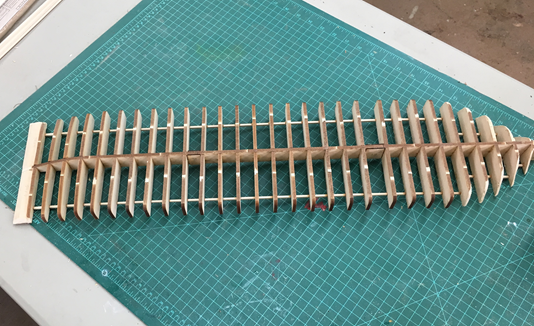
The single planking of the hull was also pretty easy (compared to the double-planked hull of the Cutty Sark, my last project).
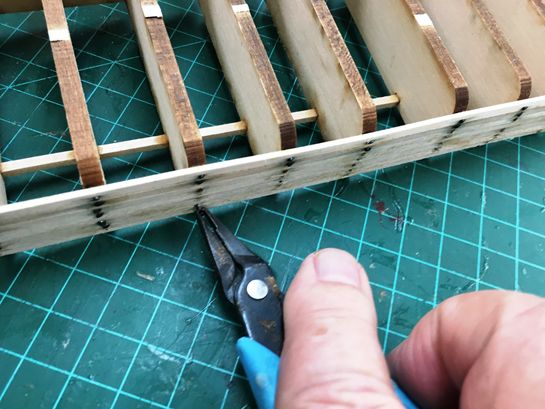
The instructions suggested that each plank be “clamped” as the glue dried, but I didn’t understand what sort of clamp would do that easily, so I used the same technique I’d learned from the Cutty Sark build (small nails) to hold the planks in place as I worked. Made the whole process a lot speedier – and the nail holes are easy to fill and hide when you finish the hull.
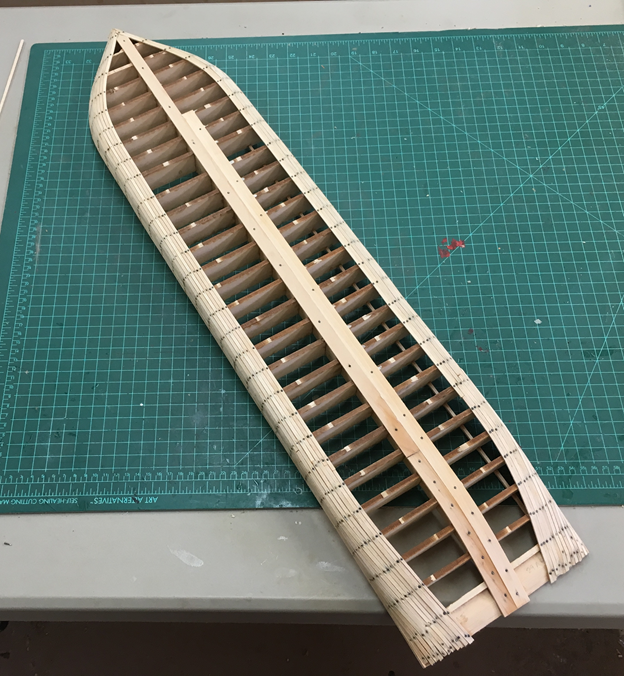

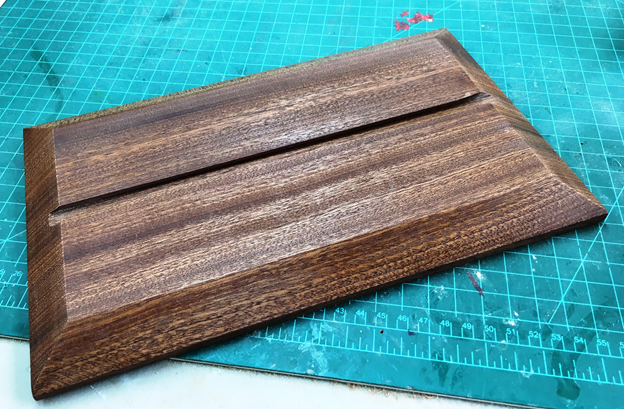
I had some nice African Sapele wood left over from my furniture building days and with it I’ll be able to make several nice bases for the models that I hope to build. In this case there’s a slot for the keel to rest in, and the final attachment is made with drywall screws that come up from the bottom and go directly into the keel.
Per the instructions, I attached the base to the finished hull and then taped it all up so it wouldn’t get marred by anything during the assembly process.
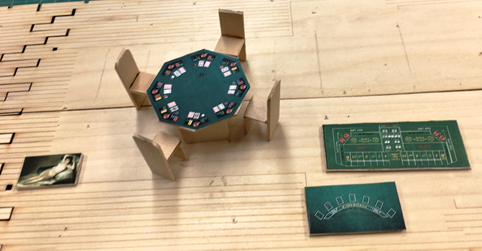
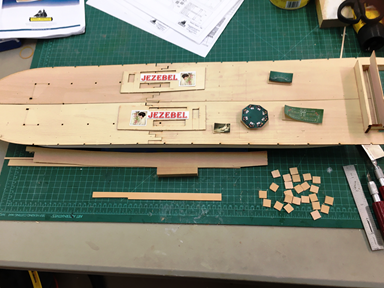
Poker table, blackjack table and craps table. Note the obligatory nude painting that will go on the back bar. You can find ANYTHING on the Internet. Once I got the main deck in place it was time to consider how to lay out the saloon and casino area I’d imagined. I also had to figure out how to successfully change the boat’s name. The wall pieces that were provided had the Chaperon name already stamped in. What you see above is PowerPoint creations that will wind up as casino table tops, and new name banners for the exterior. I made some changes later on, and will let you know when we come to them.

Even though the deck pieces were pre-scribed to indicate individual deck boards, I decide to re-plank them (partly because I like the look better, but also because I wanted them to look like mahogany decks when I was done). Can’t have old oak deck boards on a “pleasure” boat can you?
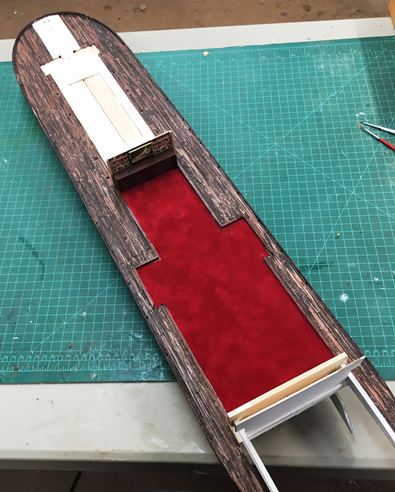
I applied mahogany stain to the deck boards, and covered the floor in the future saloon/casino area with a book cloth that simulates plush wall-to-wall carpeting. Note that the back bar element is in place here. The white decking is just to jazz up the area around the boiler and the boarding ramp.
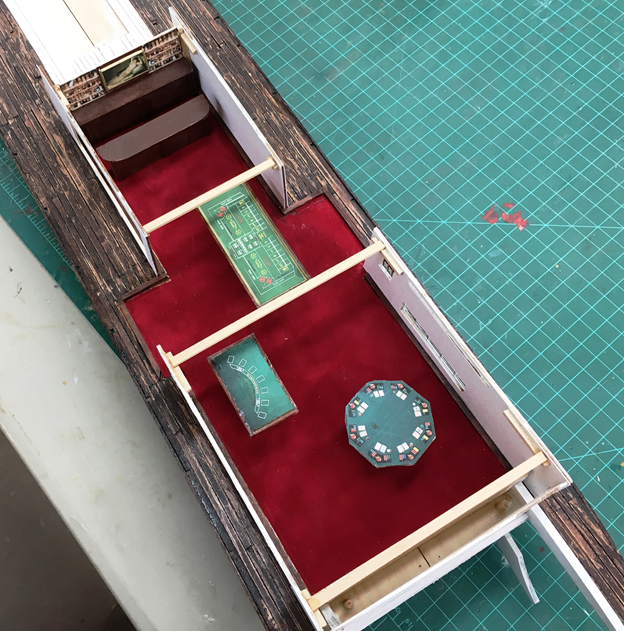
Here’s my tentative placement of the bar and casino elements. Better chairs are on their way from a supplier in England.
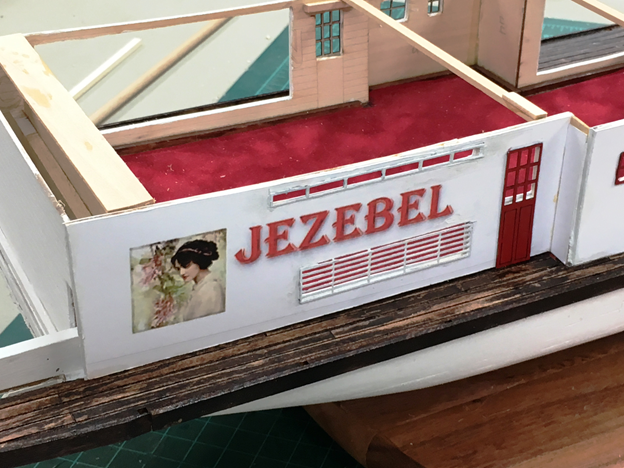
I ultimately solved my renaming problems by flipping all of the exterior walls and then covering them with matte-finish photo paper. This wall had the “Jezebel” name and suggestive artwork on it.

On the opposite walls I cut out “viewing windows” so that people looking at the model after it's finished will be able to get a peek at the interior modifications.

The front boarding stairs were a little tricky, mainly because there are quite a few small parts and a too-tight squeeze here or there during assembly can easily break them. Don’t ask me how I know that. Note the completed boiler on the deck just behind the stairs – and the inexpensive turntable that is quite helpful during ship construction.
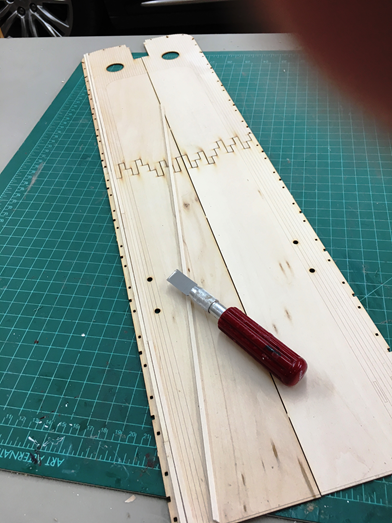
While waiting for the furniture I ordered, I started preparing the second deck – which is referred to as the “boiler” deck even though the boiler is on the deck below. In the picture above you can see the four sections glued together and the beginnings of my deck planking like I did on the lower deck. An added benefit is that my planking covers up that egregious joint between the four sections.

The walls for the bedroom area on the “boiler” deck proved to be something I couldn’t do well. Perhaps it was the material, or just that I’m not as skilled as the guy who built this thing originally.
The side and back walls all have curved ends, and according to the directions you are to bend the material using the forms that are at the upper part of this picture. Theoretically, you can simply slide the ends of the wall into the form and then gently bend them to shape. You might want to apply some heat, but wetting them is a no-no. If they still don’t bend readily, you’re encouraged to use an Exacto knife to cut the pre-scribed lines a bit deeper.
Uh-huh. You can see how well that all worked out for me.
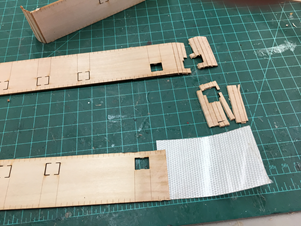

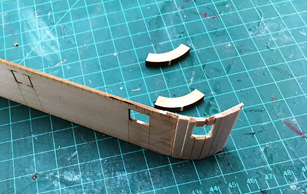
Plan B. I applied carpet tape to the place where the bends were to start, then cut clean boards the same size as the boards I ruined, and stuck them to the tape one at a time. Not particularly elegant, but it worked.
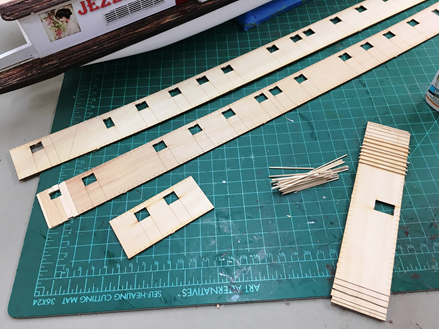
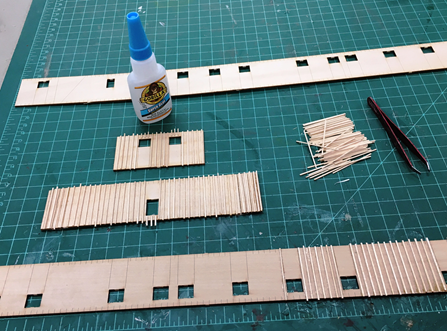

Here’s some fun. It seems that the outer boards on the bedroom walls were all installed vertically, and this resulted in the need to install vertical battens to keep them all joined. I didn’t count how many of these danged things had to be glued on, but it was more than several. Despite the tedium, when I painted the panels and put on the doors & windows, the batten effect looked pretty darn nice to me.
And it got me to thinking about the plain walls I’d created on the lower deck. Sooo…

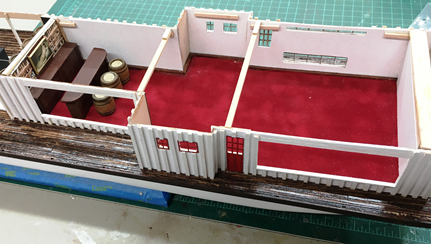
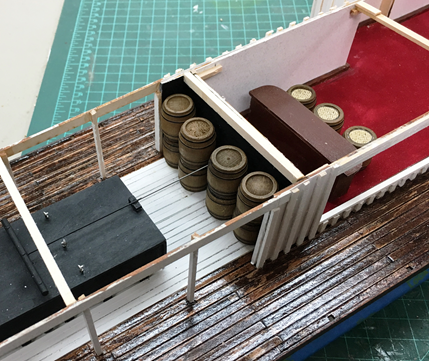
Today I loaded a pretty good supply of “hootch” where the bartender could get at it without too much trouble. Whiskey barrels also make nice bar stools.
That’s it for now. I’ll move briskly ahead when my 1/48 scale furniture arrives.
I’m not sure how I’m going to provide viewing opportunities for the expanded and more luxurious bedrooms, but hopefully I’ll think of something besides a “lift-off” top panel.
By the way, I grew up just 30 miles from Cincinnati and the Ohio River, so riverboats have always been an interesting subject for me.
If there’s a God Of Boat Models, maybe someday someone will come up with a great model of the Delta Queen – arguably the most famous sternwheeler our great inland waterways ever saw. Believe it or not, after serving many years as a floating hotel in Chattanooga, TN the old girl is being refurbished to go back into service. Hot damn.
In my younger days Newport, KY was still a pretty corrupt place, but I think it has since seen a much-needed renaissance and is a fine city to live in now. I imagine the same can be said about Hot Springs, AK. Not sure how the rich Kentucky kid’s Jezebel story will end, but I hope you are enjoying the concept.
- GrandpaPhil, Mirabell61, tarbrush and 2 others
-
 5
5
-
I just started the Chaperon kit (same as yours) and going in I decided to make up my own back story. It has a high-rolling Kentuckian buying the boat and reconfiguring it to take advantage of the rather lawless attitudes of folks during Prohibition and the Roaring Twenties. In my story the boat becomes a floating saloon, casino and, er, brothel. It will not be a "floater" or an RC boat. I don't plan to populate the Jezebel (my new name for the Chaperon) with little people, but the furniture you found is fantastic. I didn't have much problem building a craps table, a blackjack table, a poker table or a well-stocked bar. But toilets, wash basins and chairs are really hard to find. You answered the questions earlier about the little people, but the source of your terrific furniture is still a mystery. Can you please re-address that question?
Actually, your rendition of this model is beautiful and I find myself so intimidated that maybe I should just scrap what I've done so far. I won't do that, but please know that you've raised the bar for me by a ton.
Thanks, Tom in NC
-
Thanks Hof. When I was still woodworking I built a library in one room of our house, and it has plenty of shelf space for model ships. I'm going to put it in there next week since several young grandchildren are coming for a visit. Then I'll put it back where it is because it's easier for people to see and appreciate. don't plan to store any models in display cases.
All best,
TOM
-
All Followers...
I sent a question to Dan Vada (I thought) asking how I should go about adding a third and final phase to this build log. Didn't get an answer, and it was probably because I did something wrong in attempting to contact him. I don't always find this website's tools to be as transparent as an old man would like. But that's neither here nor there. Here's my third and final report, as well as several pictures of the final result.
The project took me nine months. The finish was a tad less difficult than giving birth, but not by much. I’m quite proud of the result. Along the way I was stunned by a report from Bone Doctor who sent pictures of his Cutty project. He has essentially finished the hull and deck details (beautifully) but it's taken him nine years. Yikes !!!
Along the way I had a number of kind comments and encouragements from several of you, and I really appreciated them.
I started the project Sept 1st last year, and by January I had the deck and crew quarters pretty much done … the task of rigging lay ahead. I started out with great anticipation and enthusiasm, but I’ll have to admit that by mid-month I was seriously wondering if I could ever catch on to the enormous challenge of making lines go where intended (and when). Tying even the simplest of knots was an epic struggle for me – perhaps I’m dyslexic in that way.
But enough of that, I DID get through it and I DID learn to enjoy it. You may be sure that the next fully-rigged ship I build will be MUCH better.
PHASE 3
As I looked at the detail of this particular bit of rigging, my heart sank. How does a guy with fat fingers do that I wondered?
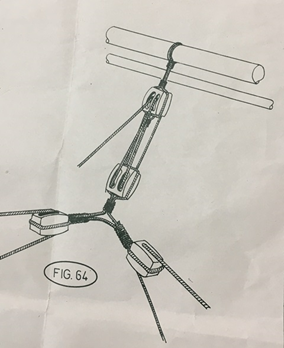
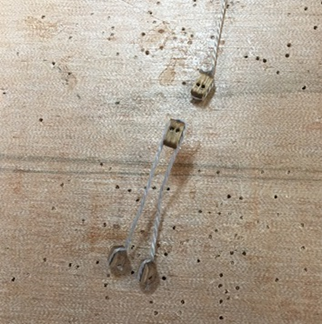
Step one – prepare upper & lower segments

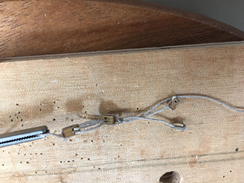
Step two – attach them with a simple connection; and Step three, weave the lines through the double blocks in the way shown in the plan drawing. Simple.

Life Boat Rigging
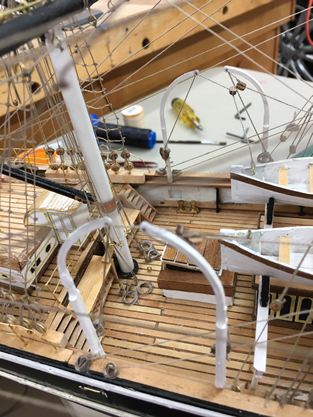
The rigging on the Cutty Sark is awesome to behold, but that don’t make it easy. How the crew handled the complexities is a mystery to me. This phase of the project was a dizzying array of line after line, and knot after knot. You have to be very careful to think through each move or you’ll find you’ve installed one line that gets in the way of another line later. The instructions aren’t much help at this point, so you have to think 3-4 moves ahead and study the drawings really well before committing. No mention at all of how you should rig the lifeboats, for instance. What you see above is my best guess.
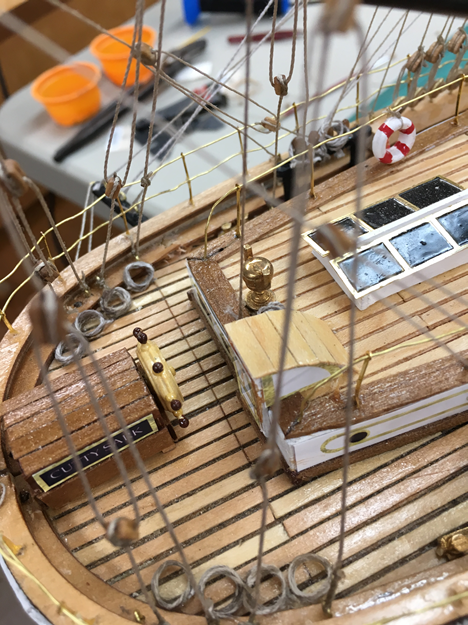
Details around the rear deck make it pretty clear that you should not attempt to install the brass handrails around the deck until you’ve finished rigging. Straightening those rascals out every time you attach another line gets pretty tiresome. Note the fine lettering on the side of the helm box, and the little rope coils that are all over the deck to lend some authenticity.
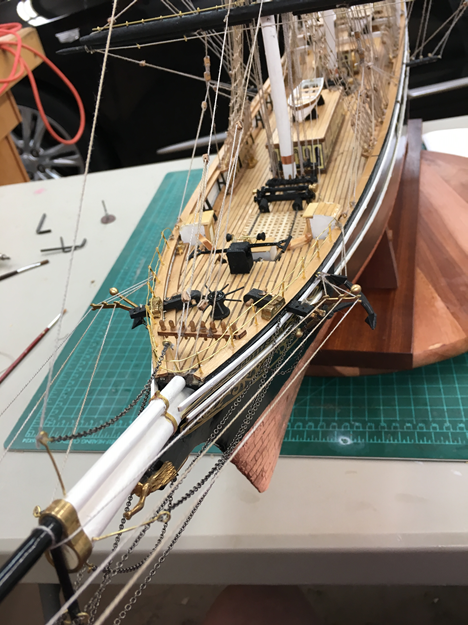
Almost done here, just adding a few lines that reach out to the bowsprit.
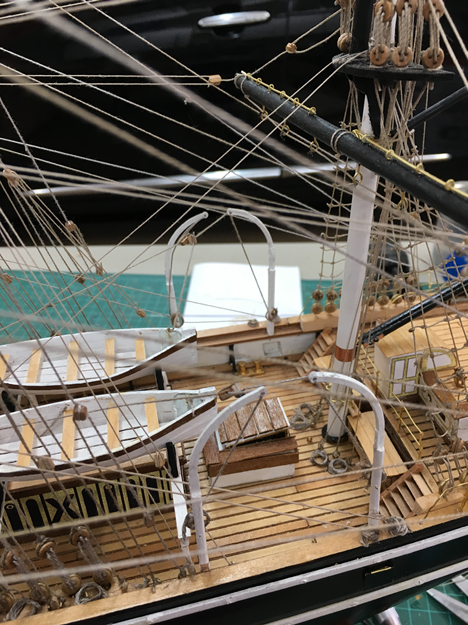
As mentioned earlier, the rigging of the lifeboats was never well-explained in the directions, so I jury-rigged them in a way that I thought they might actually work.
That’s about it. The Cutty Sark now occupies a place in the middle of our Great Room where no one can miss it. The table is a fond leftover from my furniture making days and I think it and the ship are quite compatible.
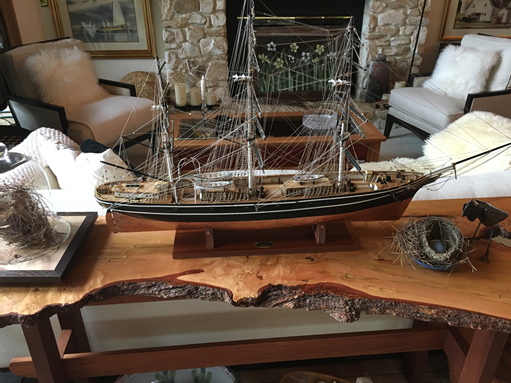
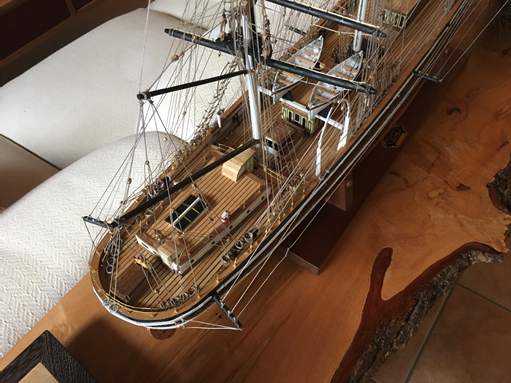
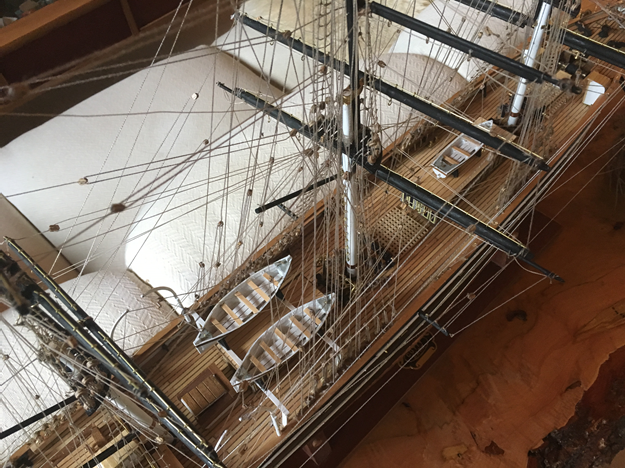
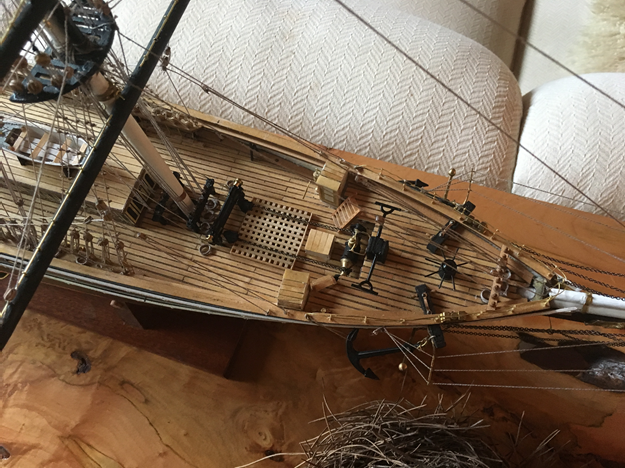


My next project will be Model Shipways fine presentation of the paddle wheel steamer, Chaperon. It has excellent packaging, excellent drawings and excellent instructions.
New back story: When I get done with her she will no longer be the Chaperon that burned and sank in 1922. In my story she will have been saved from such an ignoble end by a young Kentucky entrepreneur who recognized that Hot Springs, AR and Newport, KY were just two of several cities along the Ohio and Mississippi Rivers that had become playgrounds for the major gangs out of Chicago during the Roaring Twenties and Prohibition eras. It seemed to him that a properly equipped river boat, with all of the accouterments that gang members and others of loose morals could want (booze, gambling and girls) was a hot and potentially profitable idea.
Thus was Jezebel born. I’m sure there is no truth to the rumor that Al Capone may have caught the syphilis that finally killed him while he was aboard.
Check it all out in my next build log. It oughta be fun.
Tom from NC
tomhoxie@aol.com




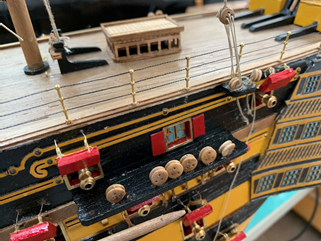
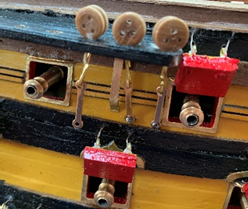
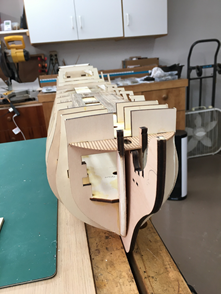
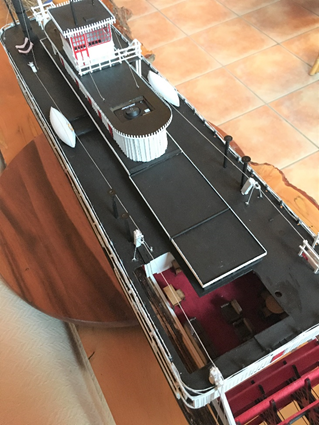

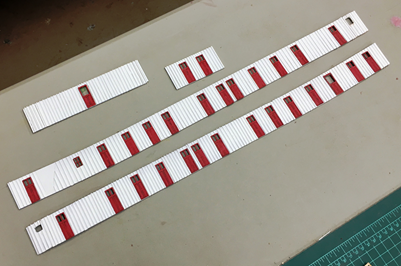
Artesania's brand new kits in 2020
in Wood ship model kits
Posted
I'm currently building the Artesania Latina Bluenose ll. It's a newly produced kit, not an old one purchased on eBay. I'm very impressed with some elements of the kit, but very disappointed with others.
This kit comes with a CD (and luckily I still have a PC with a CD slot), and the .pdf and video files on it are very nice - as far as they go. To save some time & space I'll summarize my experience - good & bad - with this model below.
* Components are all high-quality. Nice woods, fibers and metal. A few minor parts missing, but the rigging threads (while nice) are inadequate. Not enough of the heavier black fiber to complete all of the shrouds.
* That's assuming that I'm using the right weight thread for that purpose. If there was a parts list with component descriptions included with the kit I'd know.
* I was able to make my way through the hull and deck directions, and the results look great, but things get very fuzzy after that. I could get the masts assembled just by looking at the provided pictures, but then as the pace quickens the pictures (which include numbers next to each component) leave you to guess what to do. What the heck does a part number in a picture mean when there's no parts list to refer to? There are literally no written instructions after you get to mast construction.
I'll get through this. I've built a number of models and feel pretty competent. But I'll have to refer to pictures on the box cover, the pictures with indecipherable numbers, etc.
Good try Artesania Latina, but the little details count and you need to do a lot better with instructions.